#but it'll be animal bones
Text
and what if i created a handmade rosary fashioned out of real bones for my harrowhark cosplay (and just for myself as well maybe) so i could be as real-to-life harrowhark as possible
#IF I COULD JUST GET MY HANDS ON HUMAN BONES UGH#but it'll be animal bones#and obviously it wont be a cross on the end so maybe just a skull bead? i found a really cool ornate one on etsy#the locked tomb#i am slowly creating my long term project harrow costume#WE LOOK EXACTLY THE SAME AND ARE THE SAME AGE LITERALLY THE ONLY DIFFERENCE IS MY HAIR IS BROWN#I JUST DYE MY HAIR BLACK I AM LITERALLY HER#harrowhark nonagesimus
19 notes
·
View notes
Text
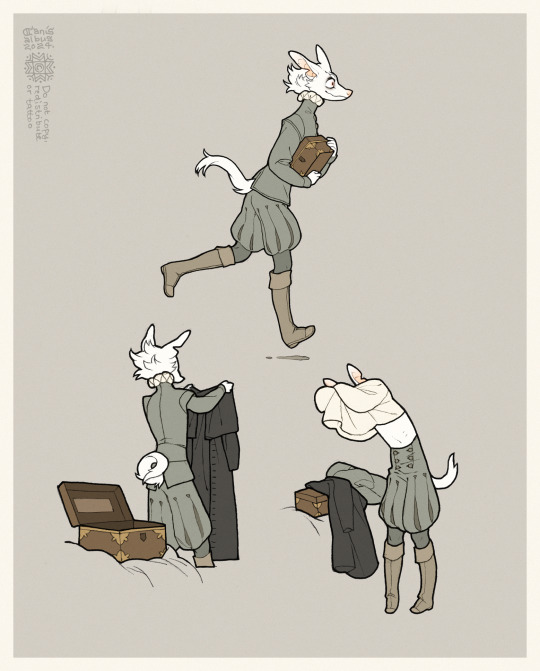
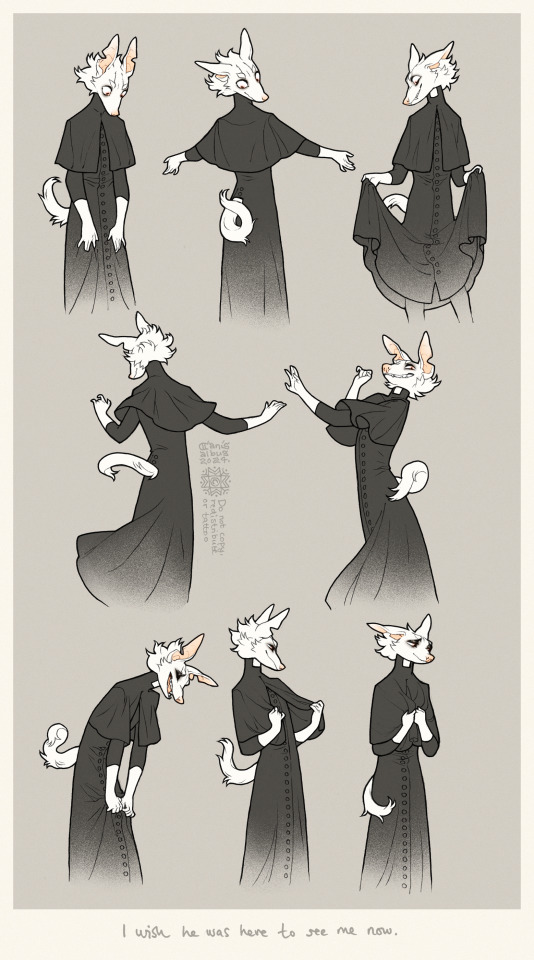
✦ Freshly ordained ✦
#a packless dog will happily accept his collar or something like that#own art#own characters#CanisAlbus#art#artists on tumblr#Machete#anthro#sighthound#dogs#canine#animals#maybe you might benefit from a little bit of context in this case#Machete becomes a priest at around 20 or so#he has trained all his life for this goal#he has worked himself to the bone and sacrificed so much#because he believes it would make him respectable and worthy and give his life a purpose and meaning#he gets his very first cassock from the tailor's and it immediately fits like a second skin#for the first time ever he feels like something he wears actually makes him look kind of nice#the hard part is over it'll be smooth sailing from here on out#there's a period in Vasco's and Machete's lives where they were apart for almost a decad#they met in their late teens when they were both studying in the same university in Venice#became friends and then lovers#but had to separate when Machete graduated and Vasco dropped out#Machete was ordained as intended and Vasco followed his father into politics#they meet again unexpectedly in their early 30's thanks to their similar jobs#Machete had became a cardinal secretary of state and Vasco was a Florentine diplomat#this takes place shortly after he had lost contact with Vasco and before he reconnects with him again
11K notes
·
View notes
Text
TW: GORE

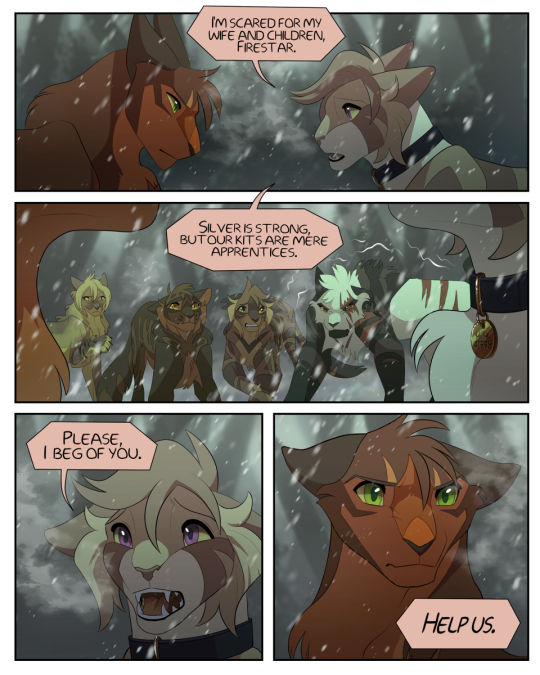
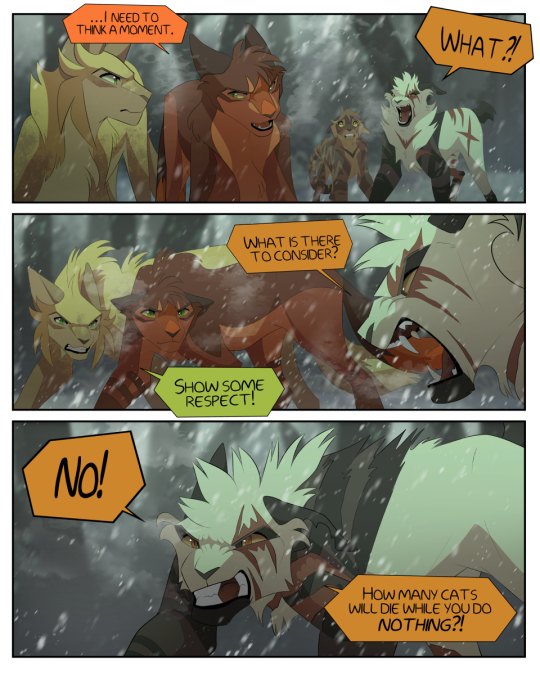
It's safe to say we won't be seeing Redrock again. :D
First | Previous | Next
Part 1: Friend and Family
See up to thirty pages ahead on Patreon!
#jumping right back into six pages a week but three are for a short comic on Patreon#it'll be released soon publically as well#gore#gore warning#tw gore#disembowlment#animal death#rip redrock#i it again where i put tons of medical detail in just to hide it with a filter lol#alas#swifthawk's chance#comic pages#blood and bone#blood#blood warning#ask to tag#swifthawk#swiftpaw#firestar#sandstorm#millie#tawnypaw#bramblepaw#goldenflower#cinderpelt#graystripe#ravenpaw#there are a few others but eh#trivia: millie's collar number is my late sister's birthday lol
354 notes
·
View notes
Text


Yoinked @neo-wolfe 's gal for a little bit of pixel animation practice!! :>
#my art#others ocs#pixel art#digital art#pixel animation#i should have a tag specifically for art i gift to others huh 🤔 since i have one for art ppl gift me#i sure do love to organize everythin i post forever. anyways lets go with#gift art from the bones#bc even if i change my url later im p sure that it'll stay bone/skeleton related akdjdjs#anyways thank you again for letting me draw gin <3#i had a lot of fun w this and i think ive got a better idea of how im gonna go about animating less simple designs#bc i was really struggling with markings/decorations/etc once i moved on from lineart stuff#ive got two more buddies OCs that im using for practice so if yall two in particular see this...they'll be coming soon 👀
19 notes
·
View notes
Text
youtube
Oh my god it's been 3 months since I uploaded to my YT channel ohno fhjf. Guess I had an excuse to practice lip sync then!
I do have a few animations in my files I would like to work on when I do have time, I've just been very busy writing a book; making games; and looking for a job lol.
Audio is Female Shepard/Jennifer Hale from Mass Effect!
(Blue Bones uses she/her)
Reblogs appreciated, thank you! 💖✨
Patreon | Tw//tter | AO3 | Itchio | Commissions | Webcomic
#if i end up fully rendering this it'll go on patreon#i would like to see it rendered :>#blue bones#my art#my animation#digital animation#character animation#2d animation#animation#animated#animator#2d animator#lip sync#Youtube#blue bones universe
3 notes
·
View notes
Text
also, the kids found a nest with a dead bird on the ground today, and they started yelling abt it n drawing all the other kids over, so i had to actually switch into the Authority Figure Voice(tm) with them so that they wouldn’t like. literally desecrate its body by kicking it around for funsies
#in general i'm just not really all that keen on using Authority Voice on children or people in general#probably bc growing up i got told a lot that i can sound really scary! actually scratch that during argumentative speeches#my prof was like 'i didn't wanna stop you outright bc it felt like you were going to snap at n kill me if i did' n i was like#'oh my god i'm so sorry no feel free to stop me whenever; it's just acting' so even Very Recently i have been told i have frightening energy#but i think mostly i don't like using it on kids bc. well. yeah i feel like it'll make them scared of me n i don't want that#like they're children. i'm not going to kill them. i'm not going to skin them alive. i hardly give punishments in general#but they're old enough to associate Authority Voice with massive trouble. like i can feel it in my bones too when i use it n i don't like it#it makes me feel like the kind of adult i'd have hated n resented the most growing up n it just makes me feel kinda ick#but at the same time it has its uses! like if it was just one to... mm i'd say like three or five kids i'd be cool w/just like#backing them up n then talking to them abt safety precautions when handling dead bodies but otherwise letting them get sticks n poke at it#but there were like five there at the start n then like five more were coming over so i was like. 'mm. cutting this short rn'#esp when one kid started kicking at the body w/o an ounce of reverence. like dude wtf why are you punting bird corpses around#but yeah i can't blame them for their curiosity; n i don't want to teach them that death is scary or dirty or anything#but wild animals can carry diseases and these kids are less than ten years old. i've seen how they handle things. they have no grace#anyway. yeah. long day at work today.#the worm speaks
3 notes
·
View notes
Text
I used to really love the first romance scene with Astarion (and I still do) but it hits so much harder after you know why he's doing it. That he's purposefully seducing you for protection and blood, that he's forcing himself to sleep with you, and this is a mask he's wearing.
It's a sexy scene and really feeds into the vampy (pun intended) jump-your-bones version of him you get at the start of the game. The whole thing starts out with him being so confident and suave, saying that he's wanted you ever since he set eyes on you and how you want to be known and tasted. It's like everyone's perfect vampire romance novel.

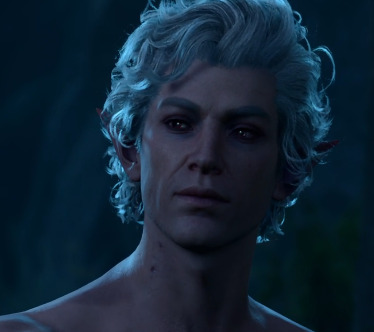
He's laying out the bait that's worked thousands of times over and luring you in. And you can just get right to the kissing if you want.
But, you can also stop and ask him, "And what do you want?"
And for just a moment the mask drops. This is not the same cocky seductive face we've had up until now. This is vulnerability showing. When has anyone asked him what he wants? When has anyone cared? Does he even know the answer to that question?

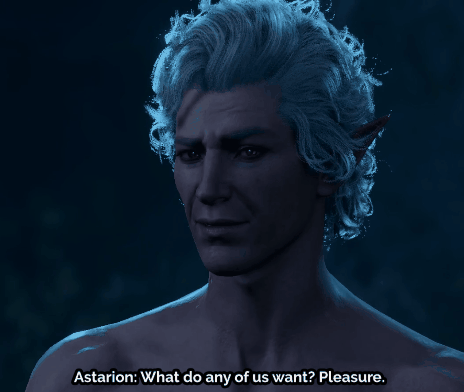
So he pivots. The mask snaps back into place immediately. He turns back into the master seducer and feeds you a line about shared ecstasy to get you back on track.
And then comes what is, to me, the pivotal moment. He asks you "That's what you want, isn't it? To lose yourself in me?"
Looking at his body language he seems unsure at first, maybe questioning his previous tactics. Then he slightly cowers back, lowering himself as he asks the question. The total opposite of his confidence from earlier where he's standing with his arms out wide.
He's not sure what you want anymore. You're not playing by the rules he knows. Why haven't you taken the bait yet? Why haven't you thrown yourself at him?




And when you finally Nod in agreement, confirming you're here for sex?
This. This is the face he gives you. He just looks so damn sad. To me, it hearkens back to "Of course it'll turn me into a monster. What else did I expect?"
Whatever momentary blip made him question why you're there with him, he's just been reassured about both of your roles in this situation.
He sounds so quietly resigned when he answers: "I thought so."
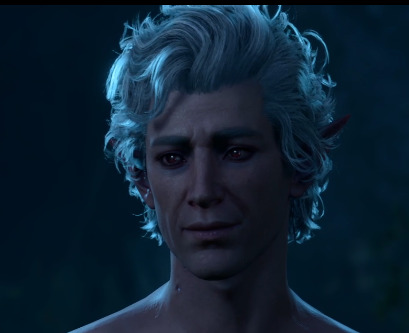

And then the scene transitions into the actual act. I do like to think Astarion enjoyed himself as I'm sure the PC did, but it's hard for me to watch this scene now that I know his story and history without being uncomfortable.
Just that line "lose yourself in me" is so difficult to hear. Because on paper it's so sensual. Who wouldn't want a lover to feel that way about them? But knowing the context of what Astarion expects and believes in this moment is just... oof.
And to me, this is what makes this scene brilliant. The writing, voice acting, and the mocap/animation are all just SO GOOD. It's so delicately done and Astarion the character is so good at playing a role that you can completely gloss over the deeper stuff. But once the mask is eventually stripped away you can't help but see what was there the whole time.
And as we've established, being seen is a whole aspect of Astarion's romance arc.
I originally romanced Astarion for the same reasons I'm sure most did: he's a hot, sexy vampire elf (i.e. everything that's on the surface). But, I keep coming back to him over and over again for the person I know is waiting for me underneath the mask.
#astarion#baldur's gate 3 astarion#astarion spoilers#astarion romance#baldur's gate 3#baulders gate 3 spoilers#bg3
9K notes
·
View notes
Text
okay so. hybrids am i right? (people clap). but wait. crow hybrid dottore (people clap and cheer). yeah. so anyways ( ͡º ꒳ ͡º) time to ramble teehee
cw: dottore x afab reader, im rambling, established relationship, light descriptions of gore and mentions of amputation. nsfw!! minors dni!!! (what did u expect from a post about an animal hybrid), possessiveness, mentions of breeding and eggs, aftercare

crow hybrid dottore who has black forearms along with sharp black nails at the end of his slender fingertips, nails that make it almost impossible for him to wear gloves because they’ll just stab through the material (everytime he files them down they come right back somehow).
some small, duvet-like feathers line the black skin of his arm, usually hidden by his coat— though they peek out from underneath the end of his sleeves sometimes. every once in a while you'll find tiny black feathers scattered around his lab when you come visit. he also has some plumage protruding from his face- more specifically the skin of his cheekbones.
crow hybrid dottore who only has one wing (replacing the fluffy mantle he normally has on his left shoulder when wearing his uniform). one wing because, when he got banished from his hometown with torches and pitchforks, his right wing got badly injured.
the trauma on the bones and his back made it so that it could never be restored to its normal shape, the wing looking like a mangled mess at all times. he'd pick out scabs and dried blood constantly, the dull pain driving him crazy- so he eventually just amputated it off himself. moving on
crow hybrid dottore who, whenever you're sitting next to him, tilts his head to the opposite side of you. you'll be keeping him company at his desk while he files reports for the mora he used for his experiments and he'll just... absentmindedly tilt his head away.
the first time it happened you didn't even notice. the second time, you thought it was just a quirky habit of his. the third time you stared at his bare neck as your fingers felt as if they were drawn to the pale skin. a thin, stray lock of hair cascaded down his neck, and you used it as an excuse to touch him. as you brushed away his hair behind his ear, a throaty noise (almost like a purr) reached your ears.
you pulled your hand back with the same speed you would have if you'd just touched a hot stove. dottore, unbothered by your panic, simply tilts his head to expose more of his skin as he absentmindedly scoots closer to you, his thigh brushing along yours. the moment he realized what he was doing he kicked you out of his office out of pure embarrassment
crow hybrid dottore who sings hums to you occasionally; usually happens when you convince him to take a walk outside to get some fresh air. its more likely to happen when its warm and sunny, and even more likely when you're eating together. it'll be just the two of you sharing lunch on your patio, sunbathing, and your ears will pick up on a soft, quiet tune he's humming. just don't tell him when he's doing it- his feathers will ruffle and he'll storm off in a huff and finish eating his food inside.
crow hybrid dottore who seems to be magnetized to the crook of your neck whenever you wake up next to him. always peppering your skin in soft kisses (and sometimes bites), he'll nuzzle into you until you wriggle your way out of his grasp. it's unlikely that you successfully get rid of him though- he rarely shows you affection during the day (unless tolerating your presence counts), so more often than not you'll let him indulge in you.
your neck and shoulders always ends up smothered in hickeys and, though they fade quite quickly since he didn't put much force in his bites, he'll gladly give you more if you want him to.
crow hybrid dottore who sometimes tosses his clothes in the corner of his bed (that he barely even uses) after he's spent time with you. he'd also throw in random things like a spare mask and some of your belongings that he snagged from you without you noticing. he says its because he doesn't want to bother himself with cleaning up, but in reality he's just... building a nest. he hates that he does this in the first place
crow hybrid dottore who loves when you reciprocate his affection. he adores it when you let him brush away the hair on your nape, when you hum just like he does, when you place gentle kisses on the junction where his neck meets his shoulder.
crow hybrid dottore who doesn't waste a single second when you're alone together after that. he'll give you more hickeys on top of your old ones, but this time he'll make sure they last. sharp teeth drawing blood at times when he gets too excited, cock straining against his pants as he ruts against your thigh.
you'll hear him coo sweet nothings in your ear while he manhandles you at his will. usually you end up on your back, legs thrown over his shoulders as he keeps a tight grip on the back of your thighs to keep you from crawling away from his cock.
"fuck, you taste so sweet. i'm going to stuff you full of seed, my clutch- nonono, don't you run away now. i know you want this."
crow hybrid dottore who almost loses his composure the first time he buries himself to the hilt inside of your snug pussy. it feels so tight, so warm around him that he almost doesn't want to pull out. almost.
he'll roll his hips against you, grinding his heavy cock in your gummy walls to get you used to his size. he knows he's a lot to handle- but this is the only semblance of mercy you'll be granted before he sees your body relaxing under him. as soon as he notices your brows lose the tension they held when he first slid inside, he'll jackhammer his cock into you and his full, heavy balls will slap against your ass relentlessly while he rambles about how he'll fill you up. again, again and again.
"take it, take my fucking cock. gods i'll never tire of your moans and whimpers. that's it, let it all out, let me hear how good i'm fucking you."
crow hybrid dottore who drinks in the noises that leave your body because they stroke his ego. he bites your shoulder when he finally cums inside to muffle his own noises, the embarrassing whimpers that threaten to leave his lips. he can't help it, you just feel so good. his hands will leave your thighs and he’ll bring his forearms to cage the sides of your head and his wing will ruffle and twitch behind him, covering your bodies in a display of possessiveness as he empties himself inside your cunt.
he'll keep his cock inside, plugging you full of his warm, sticky cum- refusing to let a single drop go to waste. if you somehow have any energy left and try to get him off of you, he'll glare and thrust into you sharply to briefly knock the wind out of you so you'll stay. he's petty like that
crow hybrid dottore who eventually relents to your whines because you're his number one weakness, and picks you up to go freshen up. he'll put your underwear back on and wipe away the sweat clinging to your skin with a damp rag. he'll soothe the bite marks and small puncture wounds his nails left in your skin with uncharacteristic gentleness, keeping his wing curled around your body to keep you as close as possible.
crow hybrid dottore who brings you back to his messy bed, to his nest, and clings onto you as you fall asleep. he'll brush your hair away from your face and nuzzle into your neck, holding your body close to his as he keeps your body warm while you keep his cum warm inside of you. it's only during the afterglow of a rough session that you get to see the stern harbinger soften up, because deep down all he wants is to keep you safe in his nest to take care of you even if he vehemently denies it
#he's in my mind 24/7 i CANT GET RID OF HIM. get him OUT!!!!!#dont actually do that. i need him there#wrote this on my phone after i woke up (no one is surprised) so dont mind any typos or funky grammar#like. wrote this with my heart fr#and my pu-#i looked up how crows show affection and mate for this#୧ ‧₊˚rambling!#tw hybrids#dottore x reader#dottore x you#dottore smut#genshin x reader#genshin x you#genshin smut#genshin impact x reader#genshin impact smut#୧ ‧₊˚cat's work!
391 notes
·
View notes
Text
he's not magic
eddie munson x fem!reader
summary: the time of the month has come and Eddie is the only person who can sooth you.
warnings: talks about menstrual cycles/blood. mentions of dying. tooth rotting fluff. Eddie is a cutie pie. pet names used; sweetheart, baby, honey. shitty writing/spelling errors; if you find any plz ignore it lolololololol.
a/n: i'm currently in so much pain from my period and the only thing i want is for someone to coddle me and tell me i'm going to be ok. i hope you guys enjoy this very small thing, it's not much and it's not good but maybe it'll help you feel good on those days when life is shit. love you all <3
--
You're dying, a slow, painful, and mournful death. At this point you stopped caring, stopping all the begging you've done all morning for your life to continue. If this was how you were going out than so be it, you just wished your end had come faster.
You've already bled through two pairs of panties and two pairs of shorts, now left in your trusty period panties and an oversized shirt. Your stomach was bloated to the point it was uncomfortable, your breasts were so swollen that your chest felt like it was going to concave under the weight, and your back felt as if it was going to snap in half at any moment.
It felt like you tried everything, ibuprofen, heating pad, and propping a pillow in between your legs - none of the tricks worked. Now you were left in the fetal position, arms wrapped around your middle and knees pulled to your chest.
For the past how ever many hours you've been moaning out in pain, the stabbing feeling in your uterus just too much to handle. You're sure if someone were to walk in and see you they'd think you were insane and right now you couldn't blame them.
You did look insane, hair wild and matted to your face from all the sweat you've accumulated, voice hoarse and scratchy from all the wounded animal sounds you've made, and your face screwed up in an unflattering way.
Your phone has gone unanswered all day, the only person to have texted you was Eddie. At first it was only tik toks, small comments he thought would make you giggle, and then it turned into him updating you about his day at work, and finally worried questions about if you were okay.
You felt so fucking guilty for not responding, not telling him that you were fine but you just physically couldn't move from your crouched position. This only made you angrier, the fact that your temporarily paralyzed and are restricted from doing the things you need to do.
The fridge sits empty and in need of new groceries, laundry stays piled up by the washer where they wait to be cleaned, and Eddie is waiting for your response worrying about your well being - that is if he hasn't already contacted the national guard to track your location.
Everything is so shitty, the pain, the hurting, the guilt, the frustration. You feel like you're a balloon that's been filled up too much and is waiting to burst at the seams.
You don't have to take long before the heated tears from your eyes fall down, hitting the bridge of your nose, only to land on the pillow beneath your head. It's not a violent cry, at least not yet, just frustrated tears that seem to slip away from their barricade.
You don't even notice the front door of your apartment opening or the sound of Eddie calling for your name, only focusing on the pulsating of your uterus that debilitates your body.
"Fuck, baby I've been worried about you," You don't even turn and look at him, your eyes are still harshly closed. By the sound of his voice you know he's out of breath, brown curls probably wild from the speed of his running.
"Shit, sweetheart, are you okay?" The worry in his voice hits right on the spiderweb crack, shattering you into a million little pieces.
You can't hold it back, the wailing that rips from your throat is something close to bone chilling. Tears streams from your eyes without relent, whole body shaking from the cries that rip from your body.
It doesn't take more than thirty seconds to feel the bed dip as your boyfriend crawls into bed next to you. He doesn't think twice before pulling you in, one arm wrapped around your back and the other soothing down your hair on the side of your head.
"It's okay, baby. M'here, you're okay." Eddie coos and it's like music to your ears.
The warmth from his body fills you in a way your heating pad couldn't. Even with the mucus that fills your nose you catch a whiff of his scent, smoke, pine, and outside -undoubtedly him. His calloused hand runs soothingly up and down your back, allowing your bones to relax into his touch.
Eddie doesn't have to ask, he knows you better than you know yourself, and the way your scrunched up on your bed and crying he knows that you've been battling your pain all day.
"Sweetheart, you have to breath. Can you do that for me? Take one big deep breath, s'all I want, okay?"
You nod your head against his chest, following the way his chest moves as he demonstrates for you. Between hiccupped breaths and streaming tears, you allow your lungs to fill up with as much air as you can take in, releasing it right after in one long exhale.
"Good job, baby. Did such a good job f'me." Eddie's being soft with you, a side of him he only allows you to see and no one else.
You let his praise melt over you, soaking it right up like the plants in a drought. For the first time since you woke up you feel lighter, something you only feel when Eddie's by you. The cramps that have been going nonstop have finally subsided, the presence of your boyfriend scaring them away.
"It hurt so bad, Eds. S'really bad today." Your voice is shaky, as if one wrong move and you can break out into another sob.
"I know, honey, but it's okay. I'm gonna take care of you, kay? I'm gonna make it all better."
You both know that he has no control over what your body decides to do but just the promise alone has your worries easing away. Your body relaxes into him, your knees slowly falling down to their normal position until your laying right up against him.
"On a scale from one to ten, where are you at?" You take a moment to think about it, really evaluating the squeezing of your organs.
"Was a ten but now it's like a seven."
Eddie hums, his hand still soothing up and down your back. A small pause settles over his words, like he's trying to wrack his brain for the next action he's going to make so you can feel better.
"How 'bout you get some rest, then when you get up we'll get you something to eat? Sound okay?" You nod again, too tired to form any sort of response.
Eddie acknowledges your response with a kiss to the top of your head, making you hum in content when he does. It doesn't take long for the tiredness of your body to settle over you, quiet snores coming from your nose in no time.
Even if his arms fall asleep and his back feels stiff, Eddie stays there with you, soothing you in your sleep to ensure that your pain stays at bay. When you do wake up he's right there, waiting for you with some water and more medicine before helping you into the shower.
He's not magic and he has no idea what to do when it comes to woman's health but Eddie Munson will be damned if a period makes his girl cry like that again.
---
#eddie munson smut#eddie munson x reader#eddie munson#eddie munson blurb#eddie munson fanfic#eddie munson x you#eddie munson angst#eddie munson fluff#eddie munson x female reader
457 notes
·
View notes
Note
I heard Ghoul fuckery is wanted and I am HERE for it. So this was an idea a friend of mine came up with, just a little something, so maybe it'll work for you?
Imagine you were taught to hunt and skin animals so blood and guts aren’t anything to you, so you can imagine the Ghoul getting turned on by you covered in blood ♡
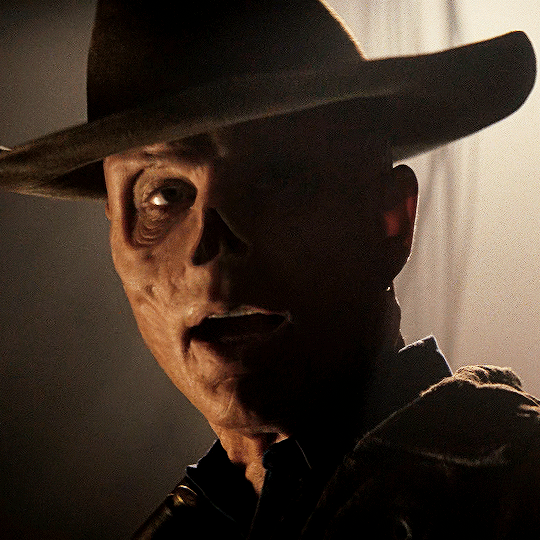
I’m literally kicking my feet and giggling at this prompt 😍 Thank you so much.
~~
Red
Cooper Howard x GN Reader (NSFW-ish)
Warnings: Animal death, blood, gore, knife mention, suggestive themes
~~
The crack of the rifle disturbs the hush of the forest. Crows take flight in alarm, rodents skitter though trees, but the doe doesn’t budge. She hovers motionless for one, two breaths before collapsing in a heap.
She goes down easy, bullet straight through the heart. Clean, painless. A yellowing grin is the only indication the Ghoul gives that he’s impressed, but you don’t notice.
Instead, you’re busy slinging the rifle over your shoulder and picking your way through the brush. That gunshot will have told everything in the vicinity that dinner’s ready. Best get to cleaning before something big comes running.
Your knees hit dirt, dust billowing up to speckle your pants when you kneel and draw your skinning knife. You waste no time in cutting away breast tissue before moving on to open up the pelvis. Bones snap, flesh and sinew part under your blade, and thick crimson wets your hands and soaks into the dirt. The scents of tangy iron and musky game fill the clearing as you diligently work.
Quiet bootfalls saunter up behind you. “Well, if I were a gentleman, I’d offer to do that for ya’,” Cooper drawls, “But it looks to me like ya’ got it handled.”
“This isn’t my first rodeo,” you quip. Gritting your teeth, you grunt with the effort of freeing innards from the doe’s body cavity. Prickling on the back of your neck tells you Cooper’s gaze is intent upon your every move.
Pausing, you glance over your shoulder to cock a questioning brow at the Ghoul hovering over you. Cooper crouches to get on your level. “Yeah, I can see that, darlin.” Leisurely, he reaches one, scarred hand out to pluck one of your blood soaked wrists from the pile of deer viscera.
From under the brim of his hat, he looks directly into your eyes as he brings your dripping hand to his mouth. Gnarled lips part and you squeak when they close around two of your bloody digits. Your teeth dig into your lip when he sucks them clean. They slide free from his mouth with a quiet pop.
He moves onto the next finger, then the next until your cheeks burn and your thighs clench. Cooper hums in satisfaction before finally releasing your wrist. Suddenly, the need for haste doesn’t seem so pressing.
The Ghoul reaches into the bloody mess between you to wet his own fingers. He brings them to your mouth to smear scarlet across your bottom lip. You taste iron when you wrap your lips around his thumb.
“Red’s a good color on you, sweetheart,” he murmurs. You watch the muscles in his jaw flex with his steadying inhale. “Let’s pick up the pace. I got other things than food on my mind now.”
#thank you for the ask#cooper howard x you#cooper howard x reader#the ghoul x you#the ghoul x reader#the ghoul fallout#the ghoul#fallout show#fallout 2024#thesightstoshowyou#cooper howard
241 notes
·
View notes
Text
Meig's Comprehensive Guide to Reptiles, aka: the vast majority of land vertebrates
Welcome! This is another long post by me, one of tumblr's most annoying resident paleontologists. But I promise: it'll be fun, it'll be engaging, and you'll be glad you read it.
What the Everloving Fuck is a Reptile?
Well, back in the day, you probably learned reptiles were land animals, with backbones, that were covered in scales, were cold-blooded, and laid eggs with hard shells.
But, you see, we classified organisms based on traits back when we didn't know about evolution. Or prehistoric life. And turns out, there are a lot of things in the past that do not fit in the categories we made based on living things today. A lot of things.
Soooooooo... now we classify based on evolutionary relationships! Aka, family trees.
So what is a reptile?
A reptile is any animal more closely related to living crocodilians (Crocs, Gators, etc.) than to rodents.

Aka, back around ~330 million years ago, animals that laid land-adapted eggs split into two groups: Proto-Mammals (that would eventually become mammals), and Reptiles.
So, a reptile is, anything closer to the group of "classical reptiles" than to mammals. Simple enough. And it is the entirety of an evolutionary unit - a single clade, consisting of a common ancestor and *all* of that ancestor's descendants.

Turns out, this includes birds, but I'll get to that.
The First Reptile Group to Branch Off: Parareptiles
So now we go through our groups of reptiles based on their evolutionary/familial relationships, and the first group to branch off from other reptiles were the Parareptiles.
(Note: Their evolutionary history is in flux and it's possible they're actually further down on the reptile tree, or not even a natural group. for now, we're going to go with them as the earliest branching group and assume they're a single thing, even though that is probably going to be very wrong in the next few years).
These were weird mfers, living from around 310 million years ago until 200 million years ago. They had robust bodies that were low to the ground, with legs *usually* sprawled out on either side. They also had very robust and broad skulls. Many of them look superficially like lizards, in that they're quadrupedal animals with limbs splayed out to the sides, but they were *nothing* like lizards. While early members of the group had long tails, over time, the bodies of parareptiles became more stout with shorter tails. They also had swollen, thick vertebrae, and stout upper limb bones. They were CHONKY.

The earliest members to branch off were the Mesosaurs, a small group of aquatic reptiles! They were long and slender, and quite small compared to later aquatic reptile groups. The next group to branch off were Millerettids, which were small insectivores with superficially lizard-like apperances. Most Parareptiles were Procolophonomorphs, and included everything from the bipedal Eudibamus to the huge Pareiasaurs that were major megafaunal herbivores during most of the Permian period.
All Parareptiles, as far as we can tell, are extinct today. Unless their evolutionary relationships change. Yay science!
All the rest of reptiles are in Eureptilia, which have smaller bones in the lower back of the skull that no longer connect to the roof of the skull. So, skulls like living reptiles!
Captorhinids
The next group to branch off are the Captorhinids, a group of interesting little reptiles with shorter tails, sprawling limbs, and weirdly boxy heads. Living from 300 to 252 million years ago, they started out as small carnivores, and eventually evolved to be large herbivores!
Protorothyridids
Next to branch off are the Protorothyridids, which lived only in the latest Carboniferous. They were small, superficially lizard-like animals, but their limbs were a lot more slender and long than lizards, as were their bodies and heads. In fact, they seemed to have been adapted for climbing trees, making them among the earliest known animals to do so!
All remaining reptiles are Diapsids, characterized by having two holes (postorbital fenestrae) behind the eye socket. This is where all living reptiles are.
Araeoscelidans
Our first group of Diapsids are the Araeoscelidans, which - again - were SUPERFICIALLY lizard like. I cannot stress enough that nothing so far has been an actual lizard. In fact, they had more slender limbs, longer tails, and less specialized heads than lizards. That said, they probably lived similarly to them, though some members may have been adapted for climbing, and others for swimming.
Unfortunately, we're now at the part of the tree where evolutionary relationships are a mess. Parareptiles may actually go here, or only some of them. Lots of different groups diverged here very quickly. It's a messssss. I will go through each group, but just know all we know is that these groups fall outside the next big chunk - Sauria - but within Diapsids.
Younginidae
Younginids are reptiles from right around the End-Permian extinction, basically only living in the latest Permian and earliest Triassic. They were as big as living monitors, and they had less kinetic (mobile) skulls than living reptiles. They would have been superficially lizard-like - again - but very different, and they had ridiculously long tails and toes, making them powerful movers.
Tangasaurids
Tangasaurids were a weird group of end-Permian to earliest Triassic animals, with some adapted for aquatic life in freshwater and lake environments, and other living life on land like other reptiles. As such, Tangasaurids represent another experiment in secondarily-aquatic life among reptiles. The land dwellers had long toes for efficient land movement, while the aquatic ones had those amazing water adapted traits that we associate more with living species. In fact, some of their tails were flattened, like sea snakes today!
Longisquama

For the sake of my sanity, I'm trying to group things up in as few groups as possible without ignoring anything. But this is a weirdo, and it doesn't have any family members, so I have to talk about it alone. You know that reptile you may have seen in books with the hockey-stick like things coming off of its back? That's Longisquama. The problem is, we don't know much about it. It had a small, slender head, and a typical reptile body, with limbs splayed out to the sides. Those fins on the back were *not* like feathers, but something else entirely - maybe just elongated scales. Or maybe it died on top of a plant (unlikely). Many bad scientists point to this animal and say its the ancestor of birds, but that's been thoroughly debunked at this point. It lived in the Middle Triassic, around 235 million years go.
Thalattosaurs
Thalattosaurs were Triassic reptiles - so living between 252 and 200 million y ears ago - that were semiaquatic! They had long, narrow skulls adapted for grabbing fish, and slender bodies for moving through the water. Their tails were long and paddle-like. Some of them had long necks, while others had shorter necks. Some even had a hook-like end of the snout for trapping slippery fish prey! They ate many different things, with a few species adapted for crunchy marine food, others for slippery, and so on.
Ichthyosauromorphs

Some of the most famous extinct reptiles go in this group - the group of reptiles that essentially evolved to be dolphins before dolphins were even a thing - a classic case of convergent evolution. These marine reptiles were extremely successful, living from the beginning of the Triassic - 252 million years ago, possibly even older - until the middle of the Cretaceous, 90 million years ago. We have early forms that show only partial adaptations to marine life, but they very quickly became fully aquatic, even giving birth to live young under water. Some of the largest marine animals ever fall into this group, including Shonisaurus and Shastasaurus. The earliest members showcase the evolution from typical reptile-shape to the weird reptile-dolphins they would become. Proper Ichthyosaurs had big eyes, round bodies, long narrow heads, and four flippers - one for each limb. Their tails were also long and ended in a fin like living sharks and whales. Some even had a dorsal fin! This group is *huge*, so I recommend digging into their wikipedia pages to learn more! Note that these are their own, huge, distinct group of reptiles - completely separate from lizards *or* dinosaurs!
Claudiosaurus
Claudiosaurus is another unique, who knows where it goes reptile, and it showcases another shift into aquatic life for reptiles during the end-Permian mass extinction. It was 60 centimeters long, and had flippers on its feet. It probably couldn't move very much on land, so it would have lived most of its life in the water. Its tail, torso, and neck were all very long, while its head was on the smaller side. Its limbs were also quite long compared to its body size. So this was a weird animal - and we're not sure where it falls in the story of marine reptiles yet. More research on this critter is needed!
Choristoderes
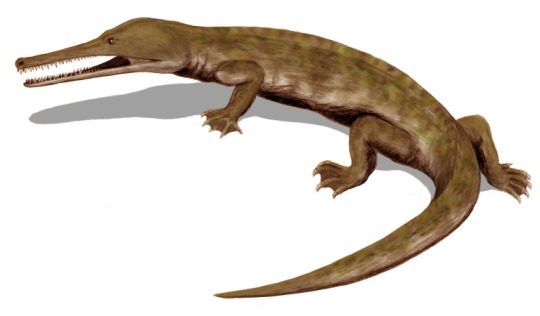
Choristoderes were semiaquatic, unplaceable reptiles that varied a lot in size over their time and managed to live through to the Miocene - so they existed from sometime in the Triassic to as recently as 11.6 million years ago! Some were as small as 30 centimeters, while others grew up to 5 meters. They were convergently similar to living crocodilians, with bodies built for semiquatic life and long narrow skulls for grabbing fish. In fact, their heads are kind of weird looking - like a heart at the base with a long projection coming off of it, if you look at it from the top. They had very simple teeth, and thin overlapping scales that were probably very soft in life. They also had webbed feet! They were exclusively fresh water animals, and may have had eggs that hatched immediately after being laid. It's wild we missed them being extant by like... a blink of an eye geologically.
Weigeltisaurids

Reptiles have evolved gliding membranes from their ribs multiple times, and this is the first one we're talking about in this article. They lived at the end of the Permian, between 259 and 252 million years ago - only going extinct in the mass extinction, though a possible Triassic fossil is known. They were not close to lizards or dinos, but had a lot of convergently similar traits to lizards. The lower ribs, aka modified gastralia, are pulled out to the side in pairs of long hollow rods, which would have supported a gliding membrane that was controlled by the abdominal muscles. They were big, which made them less efficient gliders than living gliding lizards. Their heads were very triangular, and they had extremely long tails.
Sauropterygia

Okay, so this group is going in "miscellaneous reptiles" because currently their evolutionary origin is in flux. We used to think they were close to the lizard and snake group, which we'll get to at the end of this post (long way to go). Then we thought they were close to turtles, and we didn't know where turtles went, so they were kind of in limbo. Then we figured out turtles were closer to crocodilians and birds than to lizards and snakes, so we dragged Sauropterygians there with them. And now studies are indicating that Sauropterygians and Ichthyosauromorphs are closely related, along with a bunch of other marine reptiles. And sometimes that group comes outside of crown-reptiles (Sauria, in a sec), and sometimes that group comes into the close to crocs and birds group like turtles. I don't know. I don't know where they go. They're going here.
Anyways, Sauropterygians includes a lot of weird marine reptiles. Helveticosaurs may be in this group - they had wide torsos, short limbs and tails, and a small square head, and were early marine reptiles during the middle Triassic. Saurospharigds may also go here - this group were superficially like turtles, but they were actually convergently similar, not related to living turtles closely at all (unless all Sauropterygians are?). They had elongated flat vertebrae on their backs, with matching chest ribs, to form a rib basket. Placodonts are the first definite group of Sauropterygians, which were *also* weirdly turtle-convergent. Some members of this group had huge scutes on their bodies, for part or all of their torsos, to protect them - different anatomically from turtle shells, but similar looking from a distance. They had teeth built for crushing shellfish, and had long tails to aid with swimming. Many members just looked like typical marine reptiles, however, and did not have those shells that later members had. Nothosaurs were Sauropterygians with long necks and tails and limbs that still had toes and were capable of going on land, but were more similar to the famous Plesiosaurs than the Placodonts were. Their feet were webbed, they ate primarily fish and squid. Pachypleurosaurs were similar, but had longer necks and limbs that were unable to go on land. The next group, Pistosaurs, had full flippers on their limbs, and long necks with triangular heads. This includes all Plesiosaurs, aka "Loch Ness Monsters", as well as things like Liopleurodon - many forms had very long necks, while many others had short necks, all across this group. Sauropterygians lived for the whole of the Mesozoic, showing up in the Early Triassic and lasting until the very end of the Cretaceous, and lived worldwide.
Drepanosaurs

In the Triassic, a group of mystery reptiles - possibly in this group of not closely related to anything today weirdos, possibly closer to crocs and birds - that truly showcase the weirdness of the Triassic Period. Living between 230 and 201 million years ago, Drepanosaurs had very long bodies, with flexible limbs and hands adapted for grasping branches, including opposable toes on the foot and giant claws on the hands. Their heads were very small and triangular. They had a hump on their upper backs to allow for strong muscle attachments, giving them the ability to rapidly catch insects in midair. The tails of some species ended in a freaking extra claw. In short, they were generic reptiles - or almost-archosaurs - trying their damnedest to be monkeys. And they got terrifyingly close. Some had heads that were so convergently bird like that they confused bird researchers for years, but it was convergence - in fact, the beaks of Drepanosaurs are completely different anatomically.
SAURIA
If we defined reptiles above as everything closer to living reptiles than to living mammals - ie, the most inclusive group that has crocodiles but does not have mammals - this is the *least* inclusive group that still includes every living reptile. So like, Sauropsida - where we started - is like a huge clan, with only some surviving members, but the most recent grandparent those ancestors shared was not the start of the clan, it was later on in the clan's history. I hope that made sense. Anyways, this is the group we call Crown-Reptiles.
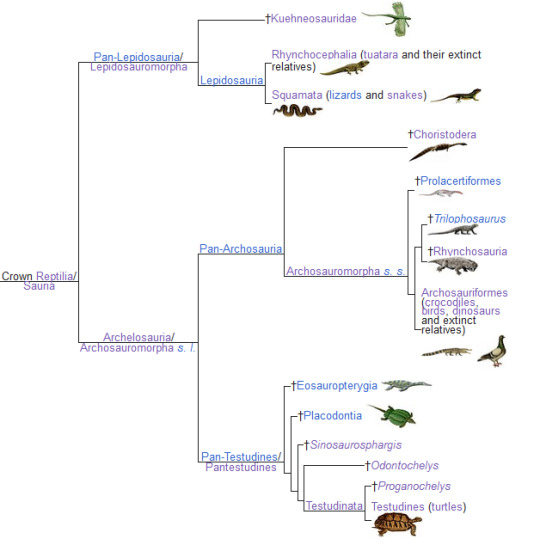
And it, by that definition, has to include birds. Because birds and crocodilians are more closely related to each other than either are to lizards and snakes. Saurians first appeared at the end of the Permian, and diversified like crazy during the Triassic when all the niches opened up after the Great Dying. We can thank the End-Permian extinction for the sheer diversity of reptiles we have in the fossil record *and* today! Because while all those lovely friends from before were great - including the ones that persist to the Jurassic - most reptiles? Are in Sauria. There are so. Many. Reptiles. In fact, today, over 20,000 species of animals are reptiles! Mammals are only 5,513 species, and living amphibians are at 7,302. Among tetrapods, Reptiles are King! Saurians come in two groups: Archelosaurs, and Lepidosauromorphs.
ARCHELOSAURIA
The first division of Saurians is Archelosauria, the group that consists of Turtles, Crocodilians, and Birds, and *all* of their extinct relatives. For a while the position of turtles was uncertain - were they the only surviving Parareptiles? Were they cousins of Lizards? But genetic data has revealed that they go with what we call "Archosaurs" - Ruling Reptiles - the group of crocodilians and birds. How their fossil relatives are or are not a part of that story is where the mess remains. Archelosaurs come in two main flavors: Pantestudines, and Archosauromorphs.
Pantestudines
All living turtles, and everything closer to them than to any other living thing, go in this group. Turtles are truly bizarre animals, because their shells are unique among animals and not repeated by any other group. During development, ribs grow sidewise into a ridge along the back, entering the skin and supporting the carapace, which is made of dermal plates that form a hard shell, that is then covered in scutes made of keratin. The lower ribs, or gastralia, along with the collar bones, extend to form the Plastron, or lower shell. The lower shell flattens out and extends on the sides to connect with the carapace. Scutes also cover this side of the shell. It's just *weird*. Turtles are just *weird*. They originally evolved from aquatic ancestors, such as Odontochelys; though some forms became secondarily terrestrial again, with many lines of the group going back and forth - making this a rare example of a secondarily aquatic tetrapod returning to the land! Turtles laugh in the face of biome preferences.
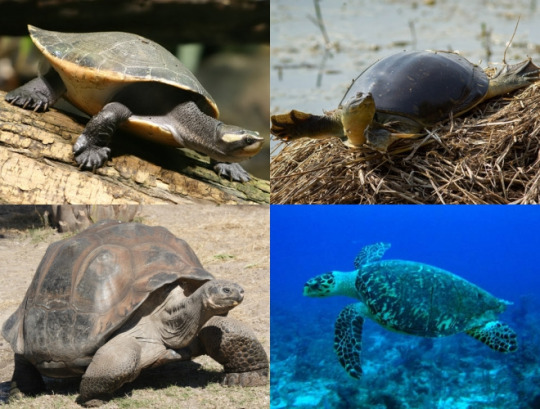
Many extinct turtles took on interesting forms, with some having large feet, others having extensive ornamentation - horns and bumps and nodules - on their heads. Some, like Meiolania, grew to extreme sizes. As the turtle group evolved, many returned to the sea, and became the largest ocean-dwelling turtles of all time - animals like the somewhat well known Archelon. Living turtles come in two main groups: side-necked turtles and hidden-necked turtles. They differ exactly how you'd expect - side neck turtles will retract their heads via the side of the body, curling it around the circumference, while hidden-necked turtles curl their neck into the body, pulling the head directly back into the shell. Most turtles - and all tortoises - fall into the hidden-necked group, including sea turtles! Turtles vary in size, limb length, head shape, and tail length, and live on every continent in the world today. In general, turtles are omnivorous, though many species show preferences for plants or meat.
ARCHOSAUROMORPHA
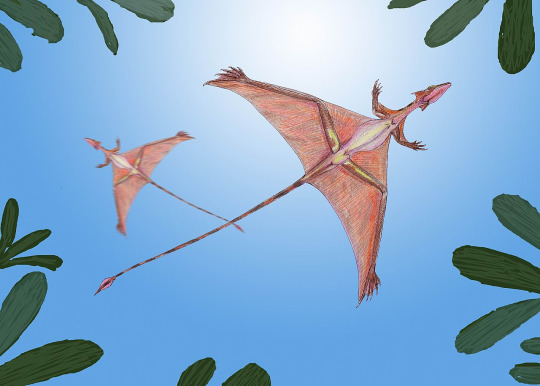
We now dive into the rest of this side of the reptile family tree, everything closer to crocodilians and birds than they are to turtles - the Archosauromorphs. During the Triassic, this group took on many different and weird forms, making the entire group one of the most diverse groups of reptiles in terms of species count and differences in shape. All of these animals have a few things in common in their skeleton, though modern archosaur features took a while to evolve. Animals such as Sharovipteryx, the long-tailed reptile that used its legs for gliding membranes, the end-Permian survivor Protorosaurus, the *ridiculously* long-necked Tanystropheus, and aquatic Dinocephalosaurus were all early branching members of this group. But as we get closer to Archosaurs proper, we see more and more weirdness.
Allokotosaurs

Allokotosaurs were weird large herbivores, with sprawling limbs and long tails, as well as short necks and boxy heads. They lived throughout the Triassic and were just bizarre. Some species even had horny beaks in the front of their jaws to help clip off plant material. One species, Teraterpeton, had a long, downward-pointing mouth. Other species had long, thin necks to reach higher vegetation. And, to just round out the craziness that is this group, Shringasaurus falls in here - a weird reptile with a sprawling body, shorter tail, long neck, small head, and horns on its head. Just for funsies. These herbivorous behemoths were some of the most unique animals of the Triassic Period.
Rhynchosaurs

During the Triassic, there was a group of small, quadrupedal Archosauromorphs that really showcase the fun of convergent evolution. See, these little animals? Were Archosauromorphs doing their best to be rodents, long before rodents would ever appear. These little herbivores had short tails, stout bodies, short limbs, and front teeth that grew long for gnawing on plants - much like living rodents. Some got as long as two meters, and these were a fixture of much of the Triassic, before going extinct during the end-Triassic extinction.
Proterosuchids
Proterosuchids were a group of Archosauriformes - so still Archosauromorphs, but now getting closer to proper Archosaurs - that were a group of predators that really capitalized on the whole End Permian Mass Extinction thing. Found only in the latest Permian and earliest Triassic, these were medium sized reptiles with long tails and stout bodies. Their heads were long and narrow, with a hooked upper jaw interlocking with the lower jaw. They looked superficially like crocodilians, but lacked the scutes that are found in said group.
Erythrosuchids

The next group to branch off, the Triassic Erythrosuchids were the apex predators of the Early and Middle Triassic, before Pseudosuchians really took over later on. They were extremely large, reaching between 2.5 and 5 meters long, with huge heads and robust bodies. When I say huge heads, I *mean* huge heads - they were robust and deep, and the upper jaw has a distinct dip that goes down lower than the lower jaw, giving their heads a very characteristic shape. They also are some of the first animals to have the Archosaur Hip Shape, so they only had a semi-sprawling posture - their limbs were more nimble!
Euparkeria
Many people have heard of Euparkeria. They even think it's a dinosaur ancestor. Well, it's not, not really. Euparkeria goes around here in the Archosaur tree, closer to living Archosaurs than the Erythrosuchids but not as close as the next group. In truth, Euparkeria is very similar to what we'd expect the common ancestor of both crocodilians and dinosaurs to be like, with fairly upright limbs - though recent studies indicate it was only quadrupedal, not capable of bipedalism. It had a long, rectangular skull, similar to early members of proper Archosauria, and osteoderms (scutes) on its back. This little guy from the Early Triassic gives us a hint as to how Archosaurs came about, with the specialized ankles we'd see in the Archosaur group first showing up in Euparkeria.
Proterochampsia
The closest group to living Archosaurs, Proterochampsians were weirdly crocodilian like, to the point of often being found to be in the crocodile line of Archosaurs! These were Triassic reptiles shaped very much like living crocodilians, with long wide bodies and tails, and very long triangular skulls. They had sprawling limbs, and scutes along their backs and bodies. The heavy osteoderms are well documented in a fully aquatic member, Vancleavea. In fact, on that side of the group, the animals had less of a crocodilian like head and more of small, tempered heads, possibly due to different lifestyles.
Phytosaurs

Okay, these guys are either actually in the crocodilian line or just outside of Archosauria, it's a huge question. They were also weirdly crocodile like reptiles that lived during the Triassic, but were distinct from the Proterochampsians. Some had long snouts with conical teeth to eat fish, but others had shorter snouts with differently shaped teeth for eating land animals. They had distinctly serrated teeth, unlike living crocodilians, and didn't have erect or even semi erect gaits like living Archosaurs. Though many specialized for life in the water, this was a very diverse group that was doing a lot of the crocodilian-type jobs of later periods, but weren't crocodilians. They didn't have the secondary palate bone that allows crocodilians to breathe when their mouths are full of water! Weirdly, they were way more heavily armored than crocodilians, with heavy bony scutes and dense abdominal ribs (gastralia) for protection. Finally, they had their nostrils near their eyes, rather than at the end of the snout - allowing for them to breathe while submerged without that secondary bony palate.
ARCHOSAURIA
This is the group of the most recent common ancestor of living crocodilians and birds, and all of that ancestor's descendants. So while everything from Archosauromorpha to this have been closer to Archosaurs to anything else, these are the proper Ruling Reptiles as we currently define them. Archosaurs have teeth set in deep sockets, extra openings in the skull, and a pronounced ridge on their femur. They also only have claws on their first three fingers of the hand - the fourth and fifth, if they have them, lack claws. Archosaurs immediately branched into two groups: Crocodilians and their relatives, versus Birds and their relatives. We will start with the Crocodilians.
Pseudosuchia
A lot of early crocodilian relatives were superficially similar to living members, so they were originally given the name "fake crocodiles" or Pseudosuchia. Then, it turns out, that group was just the ancestors of crocodilians - which underwent many different shifts and turns in their evolution - so that means real crocs are... fake crocs. Remember friends, the names we give these things? Are extremely arbitrary. Do not take them for indicators of what these things are like. Early members had very broad, bulky skulls and even somewhat upright gaits, allowing for active predatory lifestyles. Everything from here until Avemetatarsalia are all Psuedosuchians.
Aetosauriformes
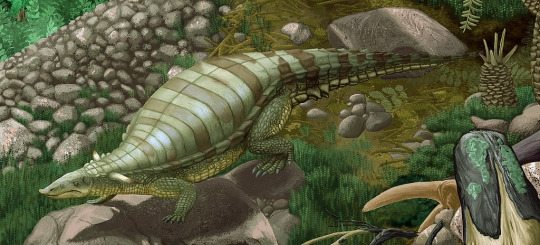
In the Late Triassic, there weren't any armored dinosaurs, but there were Aetosaurs! These animals had extreme armor all over their bodies, with overlapping scutes on their back and often spikes or other armor on their limbs and back. They also had small, triangular heads, built for feasting on a variety of plants! These were extremely common animals, often having weirdly pig-like snouts if you squint, and mostly sprawling limbs. Found worldwide, their armor would have allowed them to be protected from the many varieties of large predator reptile around them, though they still ultimately went extinct during the end-Triassic extinction.
Poposauroids
A group that used to include other animals, this weird hodgepodge of a variety of Triassic Pseudosuchians including sail-backed animals, toothless creatures with beaks, and animals weirdly similar to dinosaurs to the point of being confused with them in the past. All of these crazies had upright limbs, and in the Shuvosaurids, this lead to animals evolving into essentially scaly lithe bipeds, what we used to think dinosaurs looked like! In fact, Effigia and Shuvosaurus both had long necks, beaks in the front of their small mouths, and completely upright postures, making them just straight up look like scaly versions of their dinosaur neighbors like Coelophysis. Alas, the Poposauroids, like many groups, went extinct in the end-Triassic extinction.
Rauisuchians
The top predators of the late Triassic, these were very large terrestrial pseudosuchians, with large boxy heads and upright limbs. This allowed them to move quickly and attack prey efficiently, making them extremely well adapted hypercarnivores. In a lot of ways, Postosuchus and its relatives in this group were convergent with later theropod predatory dinosaurs - even having huge boxy heads like Tyrannosaurs would. This means that what dinosaurs one day perfected, crocodile relatives tried out first! Alas, like most apex predators, they were not immune to mass extinctions, going extinct during the end-Triassic.
Crocodylomorpha
Now, at this point, the line that would lead to living crocodilians - Crocodylomorpha - actually look less like living crocs than the Rauisuchians and Phytosaurs did at the same time! These little reptiles were quadrupedal, thin, and built for running fast - they were lithe creatures built to avoid all of those big scary animals around them. But these were the only Pseudosuchians to survive the end-Triassic! And the first group to branch off here?
Thalattosuchians

During the Jurassic and earliest Cretaceous, a common feature in the oceans were marine crocs - the Thalattosuchians! Still fairly distantly related to modern crocodilians, these reptiles convergently evolved many of the same adaptations for ocean dwelling as the Sauropterygians we met earlier. Some members, like Metriorhynchus, even evolved flippers and a tail fin! They had elongate bodies and very long, thin skulls for catching fish and other animals. They also gave live birth - possibly the only Archosaurs to ever do so!
Many more croc relatives would evolve into a variety of active terrestrial predatory niches, so we're going to jump down to the next major group:
Ziphosuchians
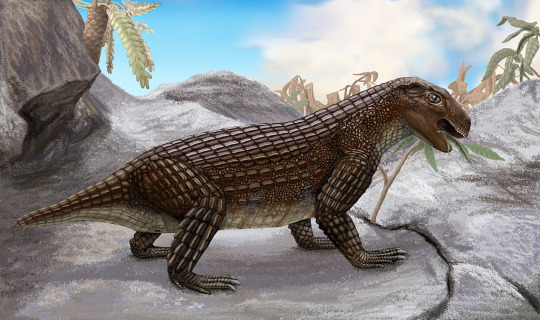
Ziphosuchians were a group of croc relatives that actually lived from the Jurassic until the Miocene, as recently as 11 million years ago. These animals were ridiculously diverse in both diet and lifestyle, with a wide variety of shapes and sizes. Some, like Kaprosuchus, straddled the line between aquatic and terrestrial predation; others, like Sebecus, were completely terrestrial and huge predators during the Cenozoic; others had weirdly diverse teeth and thus potentially unique diets; and still others just straight up evolved to eat plants or to be omnivores, even shortening and squishing their skulls to be dubbed by modern researchers as "Pug Crocs". This huge diversity of form and ecology makes Ziphosuchians an intriguing extinct group, one that will benefit from increased research in the future. Some were even built for running around, and others had duck like snouts! This was a very diverse group I recommend learning more about.
Neosuchia
The rest of Pseudosuchia - Neosuchia - are all living crocs and their closest relatives, closer than those Ziphosuchians. Many were very similar to living crocodilians, even filling similar niches, though evolving to do so independently. Some had huge, long jaws, potentially to hold onto a throat pouch for catching large prey during the Cretaceous. Some were slender, marine reptiles, evolving to be aquatic again! The Dyrosaurids were a group of global marine, long-jawed crocs that survived the end-Cretaceous extinction and were some of the only predators in the post-extinction seas other than sharks. They had teeth in deep pits, distinct from other croc relatives. While they never developed flippers like Thalattosuchians, they did adapt their limbs for more efficient marine locomotion.
Crocodylians

Living Crocodylians, a group of Neosuchians, only first appeared at the end of the Cretaceous, and were not the only surviving Pseudosuchians until relatively recently - many other forms, like the Ziphosuchians and Dyrosaurids, lasted until late in the Neogene, within the last 20 million years. Crocodylians have semi-sprawling limbs, lots of scutes all of their bodies, and even hearts like birds, pointing to their close relationship. They are semiaquatic animals, spending time both on land and in the water, and have their nostrils on the ends of their jaws. They have a sturdy second palate that allows them to hold water in their jaws and breathe at the same time! They also have some of the most powerful bite forces of any animal ever. Some extinct forms even did more terrestrial predation. Living species come in two groups - the Alligatorids, which have both caiman and alligators; and Longirostres, which have proper crocodiles and gharials. While most of them look very similar, Gharials have very long narrow snouts, while crocs caimans and alligators all have broader snouts.
That concludes the Pseudosuchia. Now we go back to the base of Archosauria, and look at the other half of their family - the bird line archosaurs!
Avemetatarsalia
All animals closer to birds than to crocodilians fall into this group. But that doesn't mean they were all shaped like living birds, just like so many Pseudosuchians looked very different from living crocodilians! They were originally characterized by having bird like ankles, though now the earliest members of the group lack them. At some point early on, members of this group evolved both warm-blooded metabolism and feathers, and we're not sure where. The earliest members of the group, Aphanosaurs, were semi sprawling long-bodied reptiles, fairly nondescript in appearance. That said, long was just their thing - their vertebrae are weirdly stretched out!
Pterosaurs
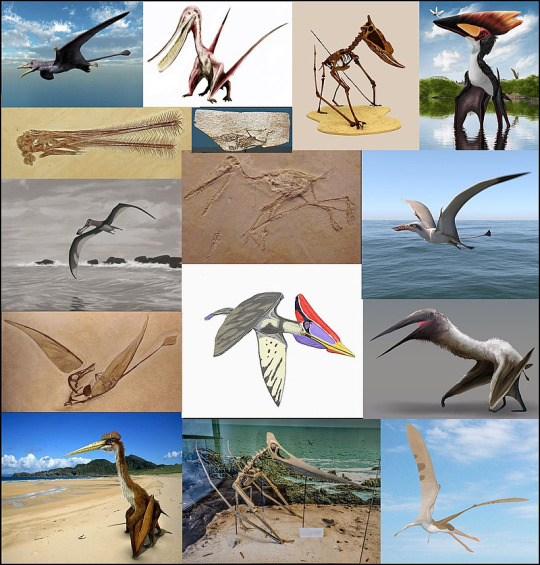
Also commonly called "pterodactyls" even though that's... wrong; this is the classical group known as Flying Reptiles, and the next group to branch from the Avemetatarsalia tree! Evolving from thin, lithe, agile floofins - things like Scleromochlus and Lagerpetids - these animals extended their fourth finger extremely long, attaching a membrane of skin and muscle to that dramatically lengthened finger and down to the ankles. Early forms had long tails, with later forms shortening the tails to smaller nubbins. These were the FIRST vertebrates to evolve powered flight. Early forms were fairly generic, but over time they diversified extensively - having diamond tail ends, interlocking long thin teeth in their jaws for catching fish; others grew bristle like teeth for filter feeding small invertebrates; some grew huge bodies, with crests and display structures on their heads like Pteranodon. The Azhdarchids, huge forms that had long necks and giant heads, were some of the most successful members of this group, becoming apex predators in many ecosystems - and no wonder, given they were the largest flying animals ever and stood as tall as giraffes. In general, pterosaurs walked on four limbs, folding up their wings at their sides in order to do so. They first appeared in the Triassic, and, alas, went extinct during the end-Cretaceous extinction. This group is so diverse and fascinating that I could go on forever, so I will leave it here - but feel free to dive into their extensive wikipedia pages!
DINOSAURS

We now move on to Dinosaurs and their closest relatives, the rest of the Avemetatarsalians. We define Dinosauria as the group composed of the two branches of the family - Ornithischians and Saurischians - usually phrased as the Most Recent Common Ancestor of Megalosaurus (a Saurischian) and Iguanodon (an Ornithischian) and all of that ancestor's descendants. Everything from here until the end of our trip through Archosaurs is a dinosaur - including every. single. bird. However, *nothing* outside of these paragraphs are dinosaurs! Dinosaurs are a single group of extremely successful reptiles, unique from all these other reptile groups - and all these other reptile groups are unique from dinosaurs. The main feature dinosaurs have in common? A completely open hip socket, allowing for limbs to be placed directly underneath the body, making dinosaurs very different in locomotion and posture than living nonavian reptiles, and very similar to their living members the birds. Early relatives showcase this evolution from semi-sprawling archosaurs to fully upright dinosaurs. Dinosaurs first appeared in the middle Triassic, though they weren't common until the Late. All the early forms were pretty much the same - small, bipedal animals, with long necks and tails, and fluffy bodies.
Ornithischians
The first main group of dinosaurs are the Ornithischians, which are united in having a small beak in the front of the jaws, called a predentary. It is possible that Silesaurids, once thought to be early Dinosaur relatives - quadrupedal lanky herbivores from the Triassic - fall in this group. All Ornithischians were primarily herbivores. Most of them were small, bipedal herbivores, but four main groups showed up over time: Stegosaurs, Ankylosaurs, Marginocephalians, and Ornithopods. Among the miscellaneous dinosaurs outside of those four groups, however, were interesting weirdos - the toothy and small Heterodontosaurs; the burrowing and armored Thescelosaurs; and, of course, the fluffy Kulindadromeus.
Stegosaurs
Stegosaurs were huge, quadrupedal herbivores with plates and spikes on their backs, necks, and tails. The plates were primarily for display and communication, while the spikes were for both display and self defense. They had very small heads, too, giving them a weird appearance. Alas, Stegosaurs lived mainly in the Jurassic, going extinct in the early Cretaceous... probably. Jury's still out based on some fragmentary fossils and tracks.
Ankylosaurs
Ankylosaurs, cousins of Stegosaurs, lived through to the end of the Cretaceous. They were heavily armored dinosaurs, with non-overlapping osteoderm scutes all over their backs and necks and heads. Many had spikes on the sides of their bodies, while other forms grew strengthened tails with clubs at the end for fighting each other. Still others grew weird sharp tail ends, formed from scutes creating a flat surface at the end of a stubby tail. They were not just like turtles, with the scutes evolving from scales rather than a shell evolving from the ribs. In fact, often times the scutes formed distinct rows along the body, not even really touching. There were tons of these dinosaurs throughout the Jurassic and Cretaceous, only going extinct in the end-Cretaceous extinction.
Marginocephalians
Marginocephalians included both Pachycephalosaurs - the dome-headed dinosaurs - and Ceratopsians, the horned and frilled dinosaurs. Pachycephalosaurs were bipedal animals, with huge domed heads and extremely strengthened tails - allowing them to butt heads and fight each other much like rams today. Ceratopsians had frills on the back of their heads - though in early forms it was very small, like Psittacosaurus - that evolved into large crests for display. Many grew horns on the side of these crests, while others grew huge horns on their faces in a variety of patterns. These horns were great for defense, but primarily served for communication and display, because some - like the curved downward horn of Einiosaurus - weren't really built for defense. Pachycephalosaurs were rare, but Ceratopsians were some of the most common dinosaurs around the world, with both groups only going extinct in the end-Cretaceous extinction.
Ornithopods
Finally, Ornithopods! Ornithopods were cousins of Marginocephalians, much as Ankylosaurs and Stegosaurs were more closely related to each other earlier. Some forms from the southern hemisphere (known as Elasmarians) were weirdly diverse, with lots of different forms from stocky and armored to small and lithe. Rhabdodonts had ridiculously complex teeth for efficient foraging, with some forms being more quadrupedal and others more bipedal. Some of the Ornithopods, Dryosaurids, evolved into extremely fast reptiles, adapted for running quickly away from predators with elongate, lean bodies. The second dinosaur ever described, Iguanodon, is from the Ornithopod group, with huge spike claws on their thumbs. Others, like Ouranosaurus, grew huge sails on their backs. While in the Jurassic and Early Cretaceous these animals were well adapted for feeding on dry hard plants, as the world grew more wet in the Late Cretaceous, they adapted to be able to chew on soft mushy plants. This huge group of Ornithopods - the Hadrosaurs- were extremely social animals, living in large herds with complex nesting sites. Some forms even grew huge crests on their heads, connected to their nostrils and lungs - allowing them to blow air through the crests, creating different sounds like brass instruments! What's really weird is that to chew that soft plant material, they grew thousands and thousands of teeth, which formed a single serrated surface for chewing. They also had weirdly long heads, superficially similar to horses; and hooves on their front feet! These diverse dinosaurs also only went extinct due to the end-Cretaceous extinction.
Saurischians
The other branch of the dinosaur family tree were the Saurischians - animals with hollow bones and lungs much like living birds, and it is from this group that birds would evolve. They come in two main flavors: Sauropodomorphs, and Theropods.
Sauropodomorphs
This is where all of the "long-necked" dinosaurs go, as well as their early relatives. In the Triassic, most of these animals were "prosauropods" - an artificial group of dinosaurs that were very successful, and from which proper Sauropods would evolve. Originally small bipedal omnivores, over time Sauropodomorphs grew longer necks, quadrupedal stances, and bulky bodies. The earliest Sauropods appeared in the Triassic, with four pillar like legs and huge torsos. Over time, a variety of different Sauropod groups would evolve. The Mamenchisaurs of Asia had the longest necks of any animal ever - reaching enormous sizes. The stocky Turiasaurs of Europe, North America, and Africa had short stocky necks and sturdy bodies. Diplodocoids included classic dinosaurs such as Apatosaurus/Brontosaurus and Diplodocus, but also weird squished forms like Brachytrachelopan, sailed ones like Rebbachisaurus, super grazers like Nigersaurus, and the weird spine-neck having Bajadasaurus. However, most sauropods fall into the group Macronaria. These were bulky dinosaurs, but evolved into some of the tallest animals ever in Brachiosaurus and Sauroposeidon. And, from this group evolved the Titanosaurs: The Largest Land Animals Ever. These were the dominant sauropods for the Cretaceous period, and were found on every continent around the world. Some grew to enormous sizes, while others were smaller; some grew armor on their backs, while others weirdly curled their tails into a spiral. Some had humps on their backs, others lost all their toe claws for maximum front limb pillar supportive action. While all other Sauropod groups had gone extinct by this point, Titanosaurs were extremely diverse and common right until the end-Cretaceous extinction.
Theropods

All remaining dinosaurs fall into this group, the Theropods. These were all bipedal animals, and where feathers were regularly retained (other dinosaur groups usually lost their feathers as they grew bigger). Early members, like Coelophysis, had long thin necks and small heads, and were efficient fast predators in the Triassic - though not the dominant ones by any means (that went to the Pseudosuchians). Over time they grew bulkier and more powerful, with display crests on their heads like in Dilophosaurus (note: it did not have a neck frill, it did not spit poison).
Ceratosaurs
The first big grouping of Theropods to diverge were the Ceratosaurs, which were bulky predators with huge skulls and progressively smaller arms. Many had horns on their heads and armor on their bodies. Some forms remained small and thin, like Masiakasaurus, and even evolved herbivory, like Limusaurus. Others, the Abelisaurs, evolved very long thick bodies - sosig/sausage bodies - and teeny tiny arms for display purposes. They primarily caught and ate other animals with their huge, sturdy, square shaped jaws.
Megalosaurs & Allosauroids
On the line leading to birds, many different types of large predators evolved. Megalosaurs - of which the first named dinosaur, Megalosaurus, is a member - were lean predators with long arms and long heads, found across Europe and North America. One group, the Spinosaurids, evolved to be huge heron like predators, living at or near the water and scooping up fish and other animals - even creating pouches in their mouths to do so. Some evolved huge sails on their backs, presumably for display. Efficient, flexible jawed hypercarnivores - the Allosauroids - appeared in the Jurassic and were some of the largest predatory dinosaurs to ever live, lasting until the mid Cretaceous.
Coelurosaurs
Coelurosaurs contains all the rest of the Theropods, and these were very birdlike animals with more complex feathers and brains more similar to birds. Here we had Megaraptors, huge predators with giant hand claws. They were also very unique in another way. Outside of mammals, terapods are not able to turn their wrists inward, ie, form "bunny hands", rendering the "T. rex" pose that many people do to mimic dinosaurs extremely inaccurate, and all the dinosaurs in Jurassic Park et al have very broken wrists. However, Megaraptors? Could turn their wrists inward. So, I guess everyone was just mimicking Australovenator this whole time, or something.
Tyrannosaurs
Tyrannosaurs were a huge group of Coelurosaurs with a variety of different members - some were small fast bipeds covered in floof with display crests on their heads; while others were bulky predators evolving bigger and bigger heads. The bulkiest known land predator, Tyrannosaurus, was one of the last members of this group. Tyrannosaurs evolved shorter and shorter arms in order to grow stronger, bigger heads - and were some of the most highly adapted carnivores in history. They lived throughout the Northern Hemisphere, and only went extinct thanks to the end-Cretaceous extinction.
Maniraptoriformes
Many different types of small, bipedal floofins evolved in Coelurosaurs - things like Compsognathus, Sinosauropteryx, and Ornitholestes. These animals progressively evolved more feathers on their arms, until finally in Maniraptoriformes we see the appearance of bird-like wings. The "Ostrich Mimics" - even though they came first - Ornithomimosaurs were dinosaurs that essentially looked like modern ostriches but with long, bony tails. These fluffy dinosaurs had simple wings on their arms for display. Some members grew huge and weird - Deinocheirus, the Demon Duck, was a huge herbivore with giant arms and a hump on its back. Evolution is amazing like that. The Alvarezsaurs remained small, and their front limbs shortened until they had a single claw on each wing - allowing them to dig up bugs and other animals from hard to reach places. Therzinosaurs grew to be upright in posture, with huge hand claws and pot bellies, allowing them to digest huge quantities of plants.
Oviraptorosaurs
The Chickenparrots - Oviraptorosaurs - were herbivorous dinosaurs with near-modern wings. They had shortened tails, and long necks, and squat bodies. They lived throughout the Cretaceous and were extremely common. Some members had huge crests on their heads; most of the later members had huge, parrot-like beaks as well. Honestly, Oviraptorosaurs were very weird and charismatic dinosaurs, and mainly ate an omnivorous to herbivorous diet.
Scansoriopterygids
At this point, one of the weirdest dinosaur groups - the Scansoriopterygids - diverged. They didn't live for very long, only found in the Jurassic of China; but they evolved membraneous wings between their fingers, making them - essentially - actual (small) wyverns.
Dromaeosaurs
Dromaeosaurs - "raptor" dinosaurs - are where we see the first signs of flight in dinosaurs, with Microraptor having wings on its arms and legs allowing for a clumsy version of flight. Most members couldn't fly, but they came in a lot of weird shapes and sizes - with some even being semi aquatic and shaped like geese! They had sickle claws on their feet, which were good for stabbing strategically at certain places in their prey, leading to the prey bleeding out. They would hold their prey steady by rapidly flapping their wings, which they could also do to move quickly up steep surfaces. These predators ranged in size from very small to bear sized, though Velociraptor - the most famous one - was only the size of a coyote. All of them - ALL of them - were feathered like living birds.
Troodontids and early Avialae
Their cousins, the Troodontids - which may or may not be closer to birds, we don't know - were also very bird like, but more slender in proportion and with smaller sickle claws. Interestingly, they had some of the largest brains for their bodies among Mesozoic ("nonavian") dinosaurs. Other forms similar to them - may or may not be in a group with them - called Anchisaurids, still retained the leg wings of Microraptor and co. Many of these animals have been preserved with complex, fluffy feathers, similar to living birds. Still similar yet, Archaeopteryx didn't have four wings, but did have fluffy legs and sickle claws on its feet similar to Troodontids and Anchisaurids. One dinosaur, Jeholornis, evolved to eat seeds; while another, Sapeornis, was one of the first dinosaurs to try out a lifestyle similar to living birds of prey.
Enantiornithines
At this point, dinosaurs lost their bony tails and grew shortened, fused tails - the tails of modern birds. They tried out lots of different forms with this - dinosaurs with ribbon tail feathers like Confuciusornis, and then the Opposite Birds, or Enantiornithines. See, living birds have a concave joint location on the coracoid (shoulder bone) and a convex joint on the scapula to link to it; in Enantiornithines, the concave joint is the scapula, and the convex is the coracoid. Enantiornithines were extremely common, with countless forms across the Cretaceous period - some were waders, others were like birds of prey, some even adapted to look like toucans with teeth. Still, all of them went extinct at the end of the Cretaceous.
Euornithes
The line to true birds, with the correct wing articulation, wasn't quite as diverse, but had many members. Many of these animals were adapted for water based life, while others evolved to be large flightless animals. Others were simple tree dwelling birds, living alongside the similar looking Enantiornithines. The closer you get to living birds, the more teeth were lost - and the modern bird beak began to evolve. Still, teeth are found in the closest relatives to modern birds, Ichthyornis and the Hesperornithes. Hesperornithes were a group of Cretaceous dinosaurs that evolved for aquatic life, spending all their time in the water hunting fish - kind of looking like a toothy penguin or loon.
NEORNITHES
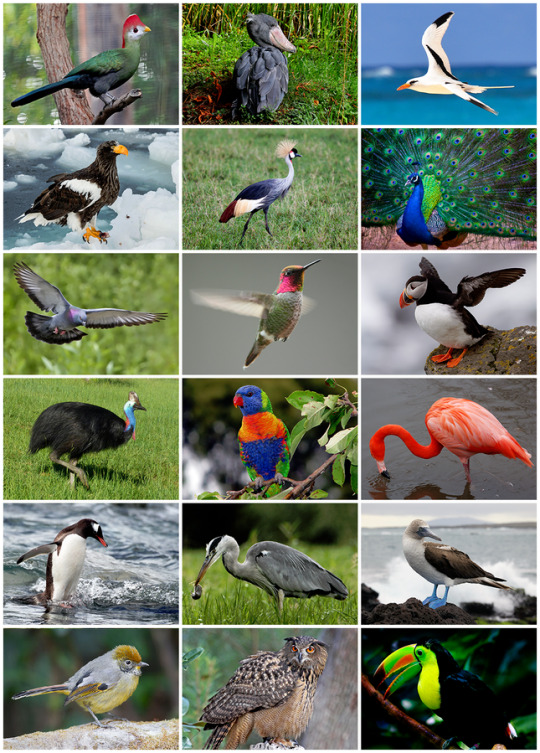
All remaining dinosaurs fall into Neornithes, the least inclusive group that still has all living birds, a derived clade of the Theropods. These were the only dinosaurs to survive the end-Cretaceous extinction. You can literally divide dinosaurs based on that extinction - everyting above this, from the Mesozoic; everything below this, from the Cenozoic. Today, half of all reptiles - over 10,000 species, possibly up to 20,000 - are birds. There is no way for me to go over all birds without losing my mind, so I'm going to summarize them as simply as I can. But these dinosaurs are, as you can see, firmly nested in the dinosaur family tree - there is no way to separate them out. What follows is the world's most efficient description of bird diversity ever.
Palaeognaths
The first major division is between Palaeognaths and Neognaths. Palaeognaths include ratites like Ostriches, Cassowaries, and Emu, but also the flighted Tinamou. It seems that this group evolved flightlessness multiple times, and did not all stem from a flighted ancestor - an extinct group, the Lithornithids, were fully flighted, tree dwelling dinosaurs of the Paleocene and Eocene (right after the end-Cretaceous extinction). Neognaths contains all other birds.
Galloanserans
Neognaths contains Fowl - chickens, ducks, and relatives - and all other birds. The fowl group, Galloanserae, has some of the only Neornithines we have fossils of from the Cretaceous. These animals come in a wide variety of forms - including the extinct, large, flightless Gastornis and Mihirungs. Ducks, Geese, Swans, Screamers, and Magpie-Geese all fall into the Waterfowl side of Galloanserae; while Chickens, Pheasants, Megapodes, Partridges, Grouse, Curassow, Guineafowl, Quail, Guans, and Chachalacas are on the Landfowl side.
One group of birds, the extinct pseudotoothed Pelagornithids, resist classification - it's unclear where they go, but they might actually be closely related to the fowl. These were some of the largest flying birds ever, and had eldritch horror mouths. Birds can't reevolve teeth - they lost the genes for enamel - so instead, some make their tongues sharp, while Pelagornithids just decided to eff up their jaws.
Neoaves
Now, the rest of birds are in Neoaves, which seems to have arisen at the very end of the Cretaceous and diversified extremely rapidly at the start of the Paleocene. This means their evolutionary relationships are a MESS and we don't really know what goes where between here and Telluraves. Different groups of these miscellaneous Neoavians include Mirandornithes (flamingos, grebes, and the extinct giant swimming flamingos), Columbimorphs (pigeons, mesites, and sandgrouse), Otidimorphs (bustards, cuckoos, and maybe turacos), Strisores (hummingbirds, swifts, potoo, frogmouth, nightbirds - the flying specialist clade), Gruiformes (cranes and rails), Charadriiformes (waders, gulls, and auks), Eurypygimorphs (Sunbittern, Kagu, and Tropicbirds), and Aequornithes (water birds). Aequornithes is an extremely diverse group, including loons, penguins, albatross, petrels, storks, boobies, cormorants, herons, ibises, shoebill, hamerkop, and pelicans - as well as an extinct group, the Plotopterids, which were boobies doing their best penguin impression! There's also the Hoatzin, which is a mysterious bird among these mysteriously related birds, that doesn't really go with anything - but man, does it smell.
Telluraves
The rest of birds fall into Telluraves, known as the tree dwelling birds, which evolved from a predatory common ancestor. These include the Accipitrimorphs, which fall into Cathartiformes - Western Hemisphere Vultures, including the Teratorns that went extinct recently - and Accipitriformes, which includes all hawks, eagles, buzzards, Eastern Hemisphere vultures, the Secretarybird, kites, and other diurnal birds of prey that aren't falcons or seriemas. Owls, aka nocturnal birds of prey, form another group in this clade, with many weird extinct forms - including the stilt-owls. Coraciimorphs are a major group of Telluraves, which includes mouse birds, cuckoo roller, trogons, quetzals, hornbills, kingfishers, hoopoe, and woodpeckers - this extremely diverse group of tree dwellers is found worldwide and includes so many weird animals (have y'all seen how the tongue works in woodpeckers? Yeah).
Australaves
Australaves is the last remaining clade, still within Telluraves, and its a group of birds that arose in Australasia. The first group to diverge were the Seriemas and their relatives, which includes all the Terror Birds - one of the most successful predator bird lineages ever, with tons of species that carried on the theropod legacy excellently in South America and then North America, only going extinct due to the ice age. Next to diverge are the falcons and caracacaras, which are very different and separated from the other diurnal birds of prey we discussed above - and also, very cute. Next up? Parrots! Finally! Parrots includes everything from the Kakapo to the Macaw, and had a lot of huge varieties over their evolution.
Passeriformes

Sister to Parrots, our last bird group, within Australaves, and including HALF of all bird species, are the Passerines - Perching Birds. Literally, there are more species of Passerines - just one group of birds - than there are of all mammals. I'm going to list them now as simply as I can, but just know, there are so many of these, and they are very diverse and very colorful and very weird and they include the second smartest animal on earth after people, the members of the genus Corvus. So, Perching Birds include New Zealand Wrens, Asities, Broadbills, Sapayoa, Pittas, Crescentchests, Gnateaters and Gnatpittas, Antbirds, Antpittas, Tapaculos, Antthrushes, Ovenbirds, Woodcreepers, Manakins, Cotingas (including the Cock of the Rock), Tityras, Tyrant Flycatchers, Scrub-Birds, Lyrebirds, Australian treecreepers, Bowerbirds, Fairywrens, Emu-wrens, Grasswrens, Bristlebirds, Pardalotes, Scrubwrens, Thornbills, Gerygones, Honeyeaters, Pseudo-babblers, Logrunners, Jewel-Babblers, Quail-Thrushes, Cuckooshrikes, Trillers, Whiteheads, Sittellas, Whipbirds, Wattled Ploughbill, Shirketits, Australo-Papuan Bellbirds, Painted Berrypeckers, Vireos, Whistlers, Oriols, Figbirds, Boatbills, Woodswallows, Butcherbirds, Currawongs, Australian Magpie, Berryhunters, Shrikes, Boubous, Tchagras, Bristleheads, Ioras, Wattle-eyes, Batises, Vangas, Fantails, Drongos, Flycatchers, Ifrits, Birds of Paradise, Choughs, Apostlebirds, Melampittas, Jayshrikes, Crows, Ravens, Jays, Satinbirds, Berrypeckers, New Zealand Wattlebirds, Longbills, Stitchbirds, Australian Robins, Rail Babblers, Rockfowl, Rock jumpers, Hyliotas, Fairy Flycatchers, Tits, chickadees, Titmice, Reedlings, Larks, Nicators, Warblers, Crombecs, Cisticolas, Reed Warblers, Grassbirds, Donacobius, Malagasy Warblers, Wren-Babblers, Swallows, Martins, Bulbuls, Babblers, Parrotbills, White-eyes, Laughinthrushes, Fulvettas, Leaf-warblers, Hylias, Bushtits, Scrub Warblers, Bush Warblers, Yellow FLycatchers, Palmchats, Waxwings, Silky Flycatchers, Hylocitrea, Hypocolius, Hawaiian Honeyeaters, Elachura, Dippers, Chats, Thrushes, Oxpeckers, Starlings, Rhabdorns, Mockingbirds, Thrashers, Goldcrests, Kinglets, Wallcreeper, Nuthatches, Treecreepers, Gnatcatchers, Wrens, Sugarbirds, Dapple-Throat, Sunbirds, Flowerpeckers, Leafbirds, Fairy-Bluebirds, Olive Warbler, Przewalski's Finch, Weavers, Indigobirds, Whydahs, Waxbills, Munias, Accentors, Sparrows, Snowfinches, Wagtails, Pipits, Finches, Euphonias, Thrush-Tanagers, Longspurs, Buntings, Cardinals, Mitrospingid Tanagers, regular Tanagers, Yellow Breasted Chat, Grackles, Blackbirds, Orioles, Wrentthrush, a bunch of weird warblers, spindalises, and Hispaniolan Tanagers.
Why the fuck are passerines so diverse, you ask? Apparently their genetic makeup leads to speciation at the drop of a hat. It's wild.
And that, my friends, is all dinosaurs. Everything from the Dinosaur header to now.
Let's go back to the base of Sauria! Take it back now y'all!
LEPIDOSAUROMORPHA
Finally, the other half of the Saurian tree! Lepidosauromorphs, unlike Archosaurs, kept a fully sprawling gait, but had a sliding joint in the shoulder blade chest area to allow for longer strides while moving, and pleurodont teeth - teeth fused to the inner surface of the jaw bone. They also retain the Parietal Eye - a small "third eye" on the top of the head found in earlier reptiles and amphibians - which is not found in Archosaurs or Turtles. Thus, these are extremely unique reptiles - though they superficially look similar to many of the reptile groups we've covered, they have adaptations for more efficient feeding and locomotion. In addition, many Lepidosaurs - including Tuatara and many forms of lizard - have tail autonomy, meaning, they can shed their tail and regrow it in order to elude predators, a feature not found in Archosaurs. This group is the group of Lizards, Snakes, and Tuatara, and all of their extinct relatives - things closer to them than to the Archosaur side of the tree.
Kuehneosaurids

Unlike Archosaurs, Lepidosaurs don't have a lot of varied and diverse extinct relatives - while Archosauromorpha is filled to the brim with weirdos, Lepidosauromorphs only have a few isolated forms showing the evolution to Lepidosaurs, and possibly the Kuehneosaurids. Kuehneosaurids were another experiment in reptilian gliding via rib extinctions, living entirely in the Triassic and completley separate from the Weigeltisaurids from earlier. They were insectivores, with pin like teeth, and very small heads. Some members were capable of gliding, while others were only really good at leaping from branch to branch.
Crown Lepidosaurs are made up of two groups: Rhynchocephalians (Tuatara) and Squamates (lizards and snakes).
Rhynchocephalia
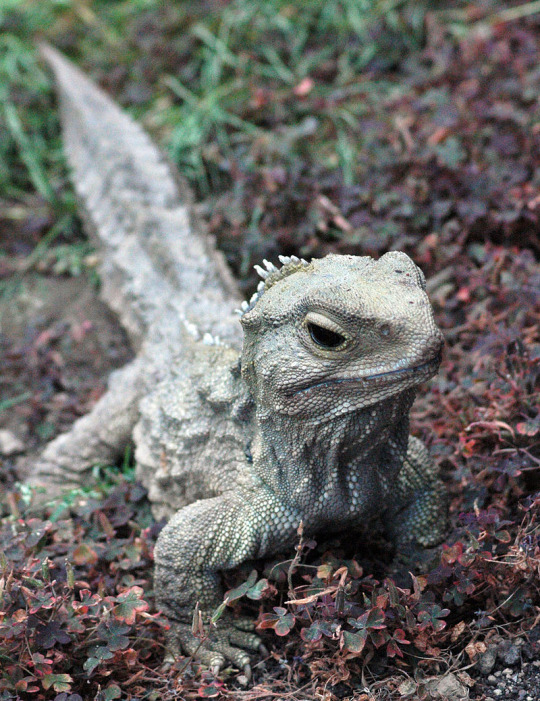
Today, there is only one: the Tuatara. In the past, they were everywhere, extremely common reptiles found around the world, especially in the Triassic and Jurassic. Compeletely separate from lizards, these reptiles had fused skull bones into a bar across the top of each side of the head, and unique teeth for digesting a wide variety of food. While the only living member looks superficially like lizards, extinct species took many forms - including one that had very small legs and a very elongate body for simming through the water (Pleurosaurus). Sapheosaurids had huge broad tooth plates, allowing them to eat hard shelled organisms. Today, the living Tuatara doesn't replace its teeth during its life, leading to a changing diet from childhoood to adulthood, switching from hard prey to softer prey as they age. Today, they are only found in Aotearoa.
Squamates
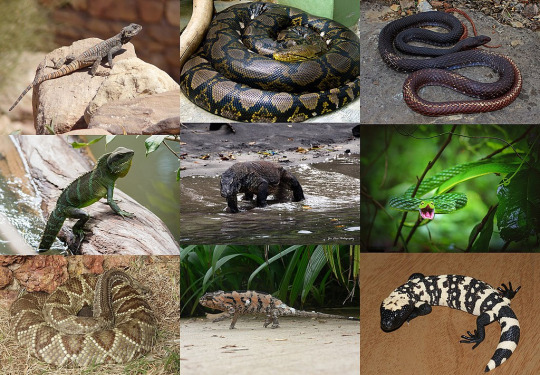
All remaining reptiles - including just as many species as birds - are the Squamates, otherwise known as lizards and snakes. Squamates aren't just generic reptiles, but highly specialized animals with very unique adaptations. They have horny scales all over their body that have to be shed via moulting, and are very differently formed than the scales found in Archelosaurs. They have movable bones in the quadrate, allowing the upper jaw to move independently. In addition, viviparity - giving birth to live young rather than eggs - evolved multiple times in Squamates, across a variety of members. And they varied extensively in size, with extremely small members less than an inch long, to huge marine members that are long extinct.
The first group to diverge are the Dibamids, or Blind Skinks, which are small insectivorous lizards that burrow into the soil. They also lack limbs, but will not be the last lizards to lose their limbs.
Gekkotans
Next up are the Gekkos - small, mainly carnivorous lizards found everywhere but Antarctica. They have a variety of clicking and chirping sounds, unique among lizards, and have loud mating calls. They are usually nocturnal, and many have specialized toe pads, allowing them to grab and climb on smooth and vertical surfaces. There are over a thousand species of Gekkos alone.
Scincomorphs
Next are the Skinks and their close relatives, the Scincomorphs. This has a lot of different forms, including many extinct ones. These lizards have cone shaped heads with very large and symmetrical scales, forming kind of a shield over their bodies. These scales are smooth and glossy. They have dermal armor, as well, and long tapering tails. There are over a thousand species, and many are found in the desertws of Australia and temperate areas of North America. Girdled Lizards, Spinytail Lizards, and Night Lizards all fall into this group along with Skinks.
Lacertoidea
Up next are the Lacertoids, a big group of diverse lizards united by having tile-like scales on their bodies, which form characteristic rings in Amphisbaenians. Members include the Amphisbaenians - aka worm lizards, yet another lizard group that lost their legs - as well as the Wall Lizards (Lacertids), Largescale Lizards (Alopoglossids), Spectacled Lizards (Gymnophthalmids), Whiptails, Racerunners, and Tegus (Teiids). This group also has over a thousand species with a variety of ecologies - and some members even are capable of parthenogenesis! Most Lacertoids are small or medium sized, though Tegus get quite big. They are slender lizards, with long tails, and a wide vareity of colors.
Toxicofera
All remaining squamates - literally all - fall into a single group, the Toxicoferans. As the name suggests, these reptiles have in common the presence of venemous members - species that produce venom and are able to deliver it to prey via biting. In fact, venom seems to have only evolved the once in reptiles: in th ancestor of this group, Toxicofera (see why a venomous Dilophosaurus, a dinosaur very far removed from this group, was ridiculous?). Containing half to sixty percent of all Squamates, Toxicoferans are to Squamates as Passerines are to Birds. There's just SO many of them. We used to not know about this group, because they don't have morphological similarities other than the venom - but thanks to genetic studies, we have been able to recover it with genomic phylogenetics. Evolution sure is fun! They first appeared in the Late Triassic, meaning all these other lizard groups diverged rapidly during that period. Toxicoferans have two main groups: Iguanians with Anguimorphs, and Snakes.
Anguimorphs
Anguimorphs include a lot of different varied lizards, such as beaded lizards, Gila Monster, Knob-Scaled Lizards, Galliwasps, American Legless Lizards, Glass Lizards, Alligator Lizards, Crocodile Lizards, and Monitor Lizards. As such, it includes the largest living lizard species, the Komodo Dragon! These reptiles can have limbs or be limbless, can have long tails or short tails, can give birth to live young, feed on insects, be hypercarnivores, be semiaquatic, or even have well developed limbs for climbing. There were also many extinct forms of this group, which were venomous and often very dangerous predators in their Mesozoic environments.
Polyglyphanodontians
A completely extinct group of lizards, these reptiles were relatives of Iguanians and were the dominant type of lizard across North America and Asia during the Cretaceous and earliest Paleogene. Many had large, blunt teeth for crushing food; others were specialized herbivores with iguana like teeth; and yet others had blade like teeth for shearing plants. Most went extinct at the end-Cretaceous, with only one form surviving into the Cenozoic and going extinct in the Eocene.
Iguanians
Iguanians, the remainder of the non-snake lizards, includes two thousand species of Iguanas, Chameleons, Anoles, Phrynosomatids, Agamids, and more - such as Collared Lizards, Leopard Lizards, Helmet Lizards, Curly-Tailed Lizards, Spiny Lizards, Swift Lizards, and Tree Lizards. Most are arboreal, but many are terrestrial. They have non-prehensile tongues, which are extremely unique and modified in Chameleons. Most are found in the Western Hemisphere, though many are found on islands around the world.
Mosasaurs
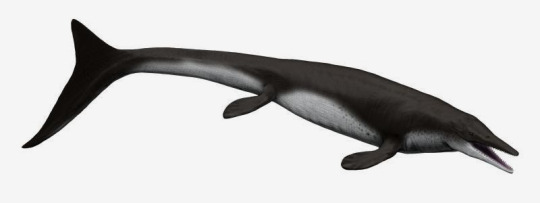
A group of large marine lizards, closely related to snakes (which we will visit next), these huge predators were a fixture of the Late Cretaceous seas, before going extinct during the end-Cretaceous extinction. These reptiles over time turned their legs into flippers, and developed fins on their tails, completely adapting for aquatic life. They had bodies similar to living monitor lizards, but elongated and streamlined for swimming. They would swim through the water with strong tail propulsions, similar to sharks and ichthyosaurs. They probably would rapidly pounce on prey, swimming extremely fast to catch them by surprise. Many were adapted for eating on shelly hard prey, while others were more adapted for feeding on fish and other vertebrates (such as other marine reptiles). They had double hinged jaws and flexible skulls allowing them to swallow huge prey whole. They gave birth to live young, and had a lot of similar adaptations for marine life to living cetaceans - kind of making them the lizard version of whales, especially given they were warm blooded. They had diamond shaped scales over their body, similar to their living relatives, the snakes.
Ophidians
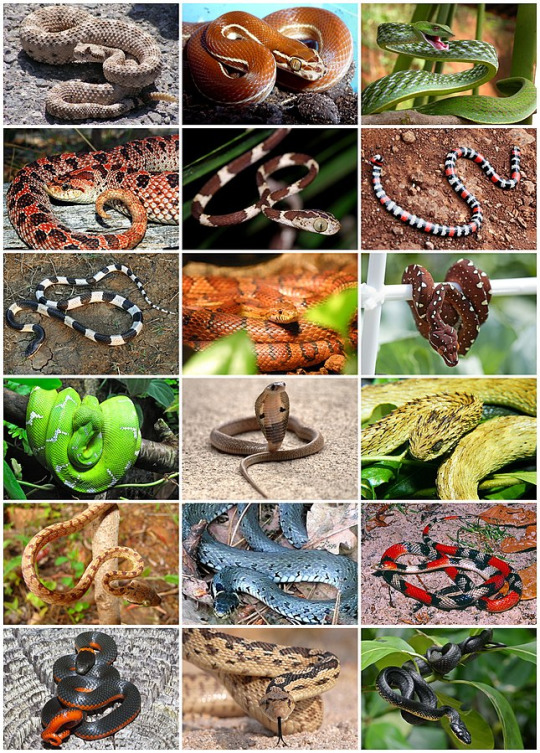
Snakes and their relatives, Ophidians, are our last group of Squamates. Firmly nested in the group, more closely related to some lizards (Iguanians and Anguimorphs) than to others, this makes snakes - by every definition - a kind of lizard. This bothers a lot of people, but there's no way around it: Snakes are highly adapted lizards. They had many extinct relatives, where all living snakes are in the group Serpentes. Early relatives, such as Lapparentophiids and Simoliophiids, show the evolution of snakes from their lizard ancestors. Some indicators show that snakes may have originally been marine - which explains the whole "Mosasaurs are closest to snakes" thing, at least somewhat. Some early fossils even showcase the reduction of the limbs, which would be lost entirely in proper snakes. However, most researchers think snakes certainly started out as burrowers, with an early relative Najash in the Cretaceous being a terrestrial burrowing animal and the even earlier Tetrapodophis also showing adpatations for burrowing life. Snakes first arose in the Cretaceous, and exploded in diversity during the Cenozoic. The puzzle of snake and mosasaur evolution is one that many scientists are actively working to solve - did snakes start as burrowers, or swimmers?
Madtsoiids
One group of snakes, the Madtsoiids, evolved in the Late Cretaceous and persisted up until the Pleistocene - so very recently - in Australia. Including some of the longest snakes known, they were either just outside the group of living snakes or the first group of them to split out (or maybe they aren't a natural group, but this post is already too long so I'll leave that there). They didn't have the highly mobile jaws of living snakes, so they couldn't swallow large prey, but they did have strong trunks to allow them to squeeze their prey like living boids. If this is a natural group, they only went extinct probably due to the climate change of the Pleistocene, or maybe due to human activity.
Scolecophidians
The nexzt group to diverge are blind and thread snakes, which definitely bolsters the burrowing idea, as many of these snakes have extremely reduced eyes and spend their lives burrowing in the ground. These snakes only use one lung and one oviduct, presumably to make themselves more streamlined and efficient for burrowing life. They do sometimes come up after rain, which is usually the only time you can see them - they do this to escape flooding in their burrows. These are small snakes, found across the world.
Amerophidians
Amerophidians, which is a very small group of unique snakes, includes the American Pipe Snake, Dwarf Boas, and Thunder Snakes. Most members of this group aren't venemous. They have very striking color patterns and are found in South and Central America. Some species are arboreal, while others mainly spend their time burrowing underground. The American Pipe Snake especially eats a very wide variety of other animals, including Caecilians, Amphisbaenids, other snakes, fish, and frogs.
Uropeltoids
This next group of snakes includes shield tailed snakes, earth snakes, pipe and cylinder snakes, and dwarf pipe snakes. These snakes are also burrowers, ranging across South and Southeast Asia. They are nonvenemous, and have distinctive patterns on their bodies. These are some of the most enigmatic snakes, with many poorly understood by researchers. They eat a variety of food, including small invertebrates as well as other snakes and vertebrates.
Pythonoids
Pythons and snakes closer to pythons than to Boas or Caenophidians are what we find in this group, though it's unclear how they're related to those two other groups (the three of them together make up most snakes). Pythons are nonvenomous snakes, suffocating their prey to kill it, and are found across Africa Asia and Australia (with invasive forms in Florida thanks to pet release and one species just native to Mexico). They are ambush predators, hiding to strike prey by surprise. Many forms have very iridescent scales, and some species do burrow and spend most of their time underground before coming up to hunt for frogs and small mammals. They reproduce with eggs.
Booids
Boas, anacondas, tree boas, and their relatives fall into this group, which are extremely common snakes in the Americas and also found in other continents around thew orld. They also, interestingly, have vestigial hindlimbs, that are spurs near the vent region. They, like pythons, kill their prey with Constriction, but can eat prey up to the size of tapirs - even swallowing prey whole, taking weeks to fully digest. They don't crush their prey to death, but rather kill them with suffocation. Unlike pythons, most booids give birth to live young.
Caenophidians
This is our last reptile group, and it includes 80% of all living snake species - basically every snake not previously mentioned. As such, this includes file snakes, racer snakes, odd-scaled snakes, snail-eaters, vipers, water snakes, mudsnakes, cobras, coral snakes, sea snakes, mole snakes, sand snakes, shovel-snouts, burrowing asps, stiletto snakes, hognose snakes, ratsnakes, and so many more. Venemous snakes - like vipers and cobras, including rattlesnakes - are in this group, but not all members are venemous. These snakes are found all around the world, and feed on a wide variety of prey items, including other snakes and lizards.
And those are the reptiles. So many weird extinct forms, so many diverse living ones, the age of reptiles did not end with the Mesozoic - instead, it adapted into the wonderful forms we see today.
I hope you enjoyed this, as long as it was, and thanks for reading!
#reptiles#lizards#dinosaurs#birds#turtles#snakes#crocodilians#tuatara#pterosaurs#plesiosaurs#ichthyosaurs#parareptiles#prehistoric life#repblr#sciblr#palaeoblr#birblr
1K notes
·
View notes
Text
Hey folks!
It has been a while! Well, we wanted to announce some big things coming your way!
WWC Askbox: Soft Re-Opening
Wednesday, Nov 1, 2023 to Thursday, Nov 30, 2023
In light of the recent attention WWC has received by the writeblr community, and the reception to our Guide to Academic Research—the mods have decided that we will temporarily reopen to your questions and test some important changes to the site! As you may have noticed, we've taken a much-needed break to catch up on our personal lives and restore our inspiration to answer the hundreds of Q&A that we receive.
Once the submission window is up on Nov 30, we will evaluate how our new system is going, tinker some more, and reopen once again once the construction dust clears.
New Rules and FAQ!
We are pleased to announce our new and improved Masterpost, which we hope will be a more centralized, more informative resource for those new and returning to WWC.
Brand-new FAQs, with new answers and content for further reading
Code of Conduct and other etiquette rules
The Ask Tutorial—a guide to writing a good ask that we’ll answer!
Moving forward, all followers are required to go through the masterpost to submit a question so they are aware of the new rules, terms & conditions.
Read the masterpost here and ask your question!
New Process
We're piloting out our own personal askbox via Google Forms. This will help us streamline the process and keep track of everyone’s questions.
We are also introducing the Deletion Log, a public, anonymous ledger that lets you know if your question (identified by a number code) has been deleted due to a rule violation, and what you can do to resubmit. Check out the Deletion Log here.
Want to submit an ask?
The below are topics of asks that we will get to right away, based on the mods who are currently active.
Black
Chinese
Colonialism
Iranian/Persian
Japanese (INCLUDING: Anime fanfic questions! Only Mod Rina will be answering anime questions, and only if she feels that the ask would make for an educational post.)
Jewish
Mixed race
South Asian: Hindu, Indian, Punjabi, Sikh (please remember that when asking about South Asia you must indicate region & time period)
Taiwanese
Writing/Publishing industry
Coming Soon: Writingwithcolor.org
We've made tremendous progress on writingwithcolor.org and are almost ready to show off the more permanent residence of WritingWithColor! However, it'll take a lot of time to fully transfer posts and links. To get the new look and all its benefits to you faster, we plan for a soft launch of the content. This will include back and forth linking between WritingWithColor.org and our home on Tumblr. We'll try to keep things seamless and your viewing experience on Tumblr shouldn't be too interrupted. Launch date is coming soon!
New Mod Applications
We still have some applications from our last call of mods and folks to respond to. So if you haven’t heard back, sorry for the delay, but no worries—we will get back to you as we start shaking the dust off our bones and getting back into Q&A. Once we are ready to invite more mods again, we'll continue our outreach.
A Special Thanks To You All
We want to thank you for your continued support, whether it’s been viewership, spreading the word about us, or sending us a tip that supports our domain and future projects for you all. The whole team really appreciates it. We will keep bringing you our best advice and guides on all things good writing with inclusivity.
Be well and keep writing!
~WWC
721 notes
·
View notes
Text

Biiig image hopefully it like translates well but oughhg vultures,,
Info/hcs about them below: (warning- long/wordy post)
General information:
Their entire lifecycle is based off bugs and thus they go through instars or larval stages of growth before they eventually cocoon and pupate and finally emerge as fully fledged adults
Through some strange modifications to their genetic and biological code, the ancients were able to make them grow their own biomechanical components through ingesting inorganic and organic material
Much more detailed under a microscope, their biomechanical structures are layered as if they were 3D printed on, but include interwoven organic components such as nerves and blood vessels
Vultures are opportunistic and will even result to cannibalism
Hatchling / 1st Instar:
multiple hatchlings will hatch all at once in a single clutch and immediately fight each other, eventually killing and consuming the loser, thus resulting in only a few grubs surviving
Nutrients gained from their siblings and material eaten from the environment around them is used to form the headpiece as quickly as possible
the modified head is used as its primary defense in the larval stage, calling adult vultures in hopes that it'll deter it's attacker- though the vultures that do arrive are most likely not the parents and will eat the grub at any given chance
5th Instar:
By now the grub has eaten as much nutrients as it could and will soon undergo pupation
The grub's first four legs have elongated to aid in travel as they will seek refuge in high perches where they will hide away and cocoon
They are swift and hard to spot in this stage because of their grime covered coat
Pupation / Near emergence:
After spinning its cocoon, the silk hardens and thickens into a tough ball
The silk is woven in with specific nutrients that promote plant growth to further hide the cocoon
After an undetermined amount of time, the cocoon gradually expands as the pupa grows into the adult form; the expansion leaves translucent areas where the silk is thin
Adult Vulture:
The engines and mask are a result of a mixture of bone-like material and metal-like material and are very hard to break
They are aware of how strong their own mask is so they stray from fighting each other, only ever attacking another vulture if they've lost their mask; this is an instinctive behavior both driven by their opportunistic nature and seeing a maskless vulture as sick or injured
As with the majority of creatures, the skin of a vulture is smooth and porous, but instead has patches of hair-like protrusions
Through a mysterious process, vultures are able to synthesize various chemicals to aid in flight, namely helium gas, which is pumped into the feathers
This process brings toxic byproducts: chlorine and iodine gas, which is forcefully expelled alongside the helium through the engines and out of the creature
A vulture's engines are raised occasionally to allow more airflow and a faster exchange of gas as standalone they accumulate these chemicals regardless of exertion
The feathers of a vulture are akin to swim bladders and are inflated with helium gas to allow the creature to fly, the feathers retain their flat shape but the skin is expanded and shows the true colors of the wings, when deflated the feathers are black in color
When on the ground, the feathers of a vulture are deflated and much tougher, their wings will curl into "fists" as they walk, occasionally extending their wings to grab ahold of things with their prolegs
Previously as a grub, they had 4 developed legs before they pupate, the mid legs turned into a pair of weak grabbing arms, mainly used to preen the creature
The grub's last pair of legs became fat reserves
The jaws of a vulture are pretty animal-like and only have a top and bottom jaw, they also have pedipalps which are used to preen, grab, and feel things
------------------------------------------------------------------------------
King Vulture:
Unknown as to how they originated, bear slightly different genetic coding compared to normal vultures, namely noticed with the mysterious brand on their masks
the vulture is larger to accommodate a second pair of lungs solely used to power the harpoon mechanism
The harpoon is shot via a swift expulsion of air similar to a sneeze, through the cables that they stiffen and expand, sending the harpoon flying at dangerous speeds
Relaxation of the cables allows them to slowly retract back on their own
#myart#rainworld#design#concept#rainworld vulture#vulture#king vulture#bugs#insect#rainworldbuilding
1K notes
·
View notes
Text
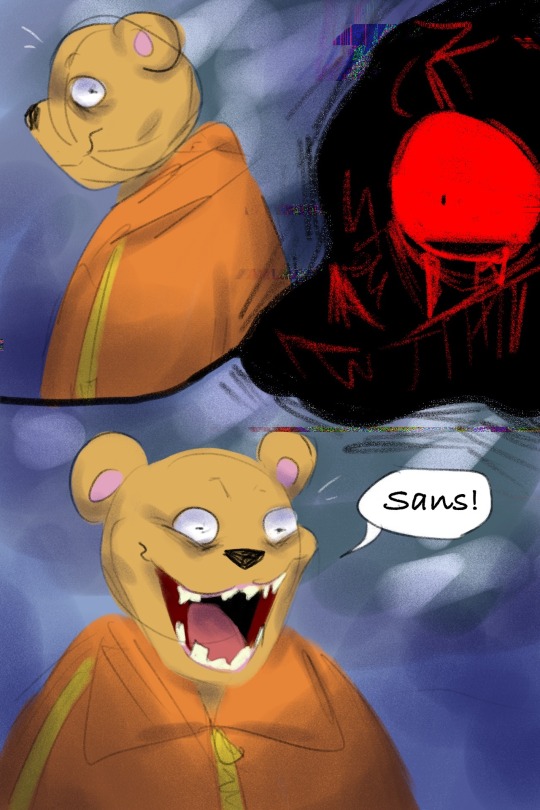


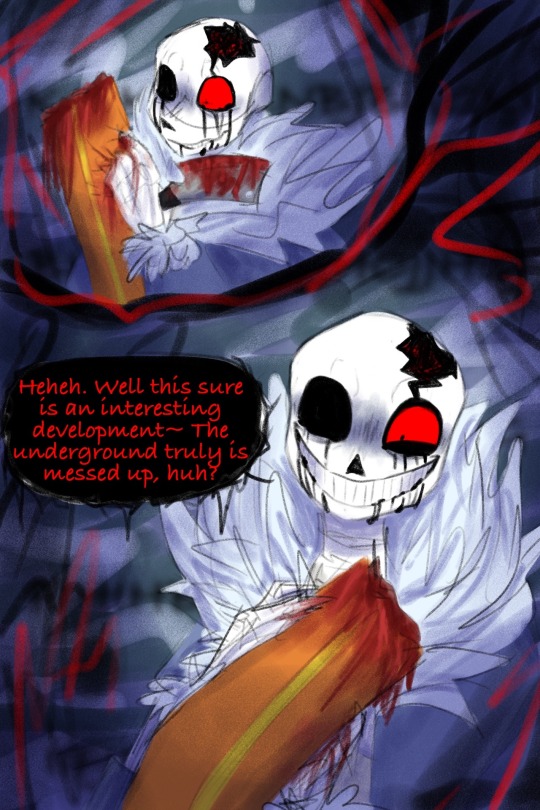
Previous
First
Unfortunately it ends here but errrrr... yuh guess what happens next :3 (details will be written later) sighs I am fully aware there were more efficient ways to post these but this week literally destroyed me so errrr yeah life's great guys(it'll be better from now on)
Oooookay ranting time!! This is gonna be a lot so..... I'd be surprised if you even read it
Based off of real complaints from multiple people, horror doesn't fit in the mtt. For a few reasons anyways...... I won't go into details on that, but ya I decided to make him worse :3 we're travellin' to cannibal horror😈 instead of eating humans he eats actual monsters tho. Because of the lack of magic and also the monsters desperate needs they're slowly turning into flesh and bone.... something horror can actually eat. Not all monsters r flesh and bones though, like papyrus for example(I killed him off guys I'm so kawaii UwU) but anyways.... by just having something in his mouth, horror's starvation gets the better of him and he goes on the hunt... and is essentially insane. I just think... he'd either eat too much or too little, sometimes accidentally starving himself and sometimes going too crazy and just. Eats too much. Either way it's resulted in a lot of vomiting..... he's kind of self aware but he's just too insane to be bothered, and kind of getting bored he gets creative with his food(prey). Sometimes he may psychologically torture them, he likes the hunting games :3 he may add soemthing to his food to see if it'll get better, and he learns a way to add monster dust to his food..... I also think it'd be silly if he studied anatomy as a part of his.... scientific side. The anatomy of critters and underground animals, so if he decides he cares enough he can actually like. Make meat out of. Yk.
As for the bad Sanses part... horror does have Lv but it's rather low bc he works more with psychological torture and cleaning up. He has fed the others human before but he's the only one that can be considered cannibal, considered he ate actual monsters. Anyways he's rlly unhealthy w food bc. Like I said, he either eats too much or too little. He learns more about cooking with nightmares books(he just got books of everything rlly) and bc of his own situation he tries to get the others to eat healthily. I don't think he'd like- take care of his own eating though... bc thoughts r getting back at him. This results in a lot of starving hismelf(cutely repeats myself a bagillion times) which results in a lot of.. "hunger pangs". Like how he reacted to fried human(Aliza) in the actual horrortale comic. So he's got bad first impressions generally...(trying to eat the others)
168 notes
·
View notes
Note
May I request the FNAF movie with a reader possessing Sparky? They’re an adult or in their late teens as opposed to the kids. They don’t “wake up” often but when they do they have a commanding presence over the others.
YES thank you for this Sparky ask-
15 year old me would have flipped her lid if she knew a FNAF 1 hoax would become canon in a movie

........
First...it was the distant muffled screams that awakened your systems, mechanical eyelids slowly fluttering open.
Then..there were louder sounds. Clearer sounds:
A woman's screaming cut short.
Bones crunching.
Flesh squelching.
And finally, something heavy hitting the floor with a thud.
Only then were you fully alert.
As your optics adjusted to the dimness of the backstage room, you realized that it wasn't just the old costumes and springlock suits that were keeping you company.
Freddy was here, too...with half a human corpse laying at his feet.
Your eyes widened out of shock.
Although you've seen him and the others kill before, what he did to that woman was quite abhorrent.
You didn't even think was possible for him to-
"You're awake."
Blinking, your head turned to see the Golden Freddy suit lingering by the door, standing up. His mouth didn't move, but you could tell from his single functioning eye, which was pulsating with a soft blue glow, that the child possessing him was talking to you.
All you could do was glare, your suit's mouth opening. "What is the meaning of this? Why are you letting them act like animals?" Your voice spoke.
In the blink of an eye, he was replaced by a blond boy in a striped shirt. He walked over to you, taking your paw and helping you stand. "It's not me. Some bad people broke in and tried to hurt them. Three others were with her, but they've all been taken care of."
As annoyed as you wanted to be, you knew you couldn't blame them for wanting to protect themselves.
Hell, you didn't even know what fully happened.
Maybe it was justifiable.
"Fine. Bring them here so we can hide the evidence...assuming we have enough room to hide all of it, of course."
The boy just smiled innocently, pointing to where you were sitting.
"Don't worry, there's always enough room for everyone."
You briefly looked to the empty purple Freddy suit that laid in pieces beside you, huffing. "I guess it'll do...I just hope they didn't leave too much of a mess-"
When you looked back to where the boy was, he had vanished completely.
He liked doing that a lot.
You're just relieved that there's at least ONE person you could talk to after being stuck in this pizzeria for.....
For.....
It suddenly occurred to you that you had genuinely forgotten how long you've been here. And the same holds true for the other children...who couldn't even remember their own names anymore. Now they only respond to the names of their characters.
Although there were significant gaps in your memories of being alive, your latest one was of the day you saw a yellow rabbit leading some kids away--taking them one at a time to show them a "backstage tour".
After the fifth one vanished, you followed him, but for some reason....he got angry that you did so.
It's like he didn't want you to see something.
Next thing you knew, you woke up, looking through the eyes of Sparky the Dog--a character you remembered from a diner that once collaborated with Freddy's for a short time.
At some point he was retired, as he kept breaking down while performing to the point where the owner didn't wanna keep repairing him.
And so Sparky--and you--were shoved backstage, being used for nothing more than spare parts.
Unfortunately, that led to you scarcely waking up and roaming like the rest of the Fazbear Band. But whenever you did, they all seemed to listen to you for some reason, doing whatever you asked of them like obedient dogs.
Ironic, considering you were the one possessing a dog.
However it seems you've woken up a tad bit too late this time, as apparently a group of adults have broken into the place, and without your guidance, the gang took it upon themselves to deal with it how ever they could.
But it seems they left quite the bloody mess...or at least Freddy did, given the red stains on his teeth.
You approached him, stopping only to point at the half-eaten body. He seemed to recognize your expression as the "I'm not mad, just disappointed" look, and his ears flattened in slight shame.
If only he could talk to you so he could explain himself..
Before you could give him an order, the doors creaked open, and you both turned around to see Bonnie, Foxy, and Chica slowly filing into the room.
Each of them dragged in their own brutally-slain victim, the intruders he must have been talking about:
Bonnie brought a man who had blood oozing from his mouth, palms covered in the same sticky substance.
Using his bloodstained hook, Foxy struggled to carry the weight of a younger man covered in deep gash marks and bite wounds on his head.
And in Chica's grasp was another man whose face had been chewed off by her Cupcake--arguably the most brutal way a person could die.
All at once, they stopped and dropped the corpses to the ground, staring at you and awaiting further directions.
You assessed each one before turning just your eyes towards the wall where you often sat deactivated, pointing to the various suits laying there.
Immediately, they knew what to do, and you also got to work helping them hide the "evidence" and making these intruders part of the band.
Forever and ever
#clanask#anonymous#fnaf x reader#five nights at freddy's x reader#fnaf movie x reader#fnaf sparky#animatronic reader#fnaf movie spoilers
772 notes
·
View notes
Text
Clone^2 - graveyard shift
The dinging of the door alerts Sarah of someone walking in, and she barely glances up from her phone to see who it is. It's past midnight and somehow her coworker John managed to convince her to take over his graveyard shift at their convenience store. He owes her one, because she's been standing here for an hour and nobody's come in.
Not a surprise to her - nobody likes to stay out past sundown in Amity Park, even after nearly three years of ghosts appearing all over the place.
But still, it happens sometimes. So she doesn't look up. The dinging bell just lets her know that it's not a ghost, and that's really all she can ask for. The last time she worked late and a ghost came in, she was cleaning the shelves from some weird goo for an hour.
However, the lack of footsteps in the store after a few seconds worries her enough that she forces her head to lift. And a frown weaves its way onto her face when she sees no one at the door, nor anyone in the closet aisles.
...Shit, was there really a ghost here? Can they ring door when they come in? Normally she sees them just phase right through. And normally they glow, bright and jarring that leaves a migraine building behind Sarah's eyes.
Her eyes quickly scan the shelves again, looking for anything out of place -- anyone with too many heads, or too many teeth, or snakes for hair. She's pretty sure a coworker saw that once when they were working graveyard.
But she still sees no one. Apprehension raises the hair on the back of her neck, and she straightens up from her lean against the counter. Fuuuck. Was this one of those... marshmallow ghosts? An animal ghost?
Sarah really does not want to have to fight off a three-eyed raccoon looking-thing with eagle feet. She's heard the horror stories. And there was no way to contact the Phantom or the Red Huntress to come pick it up -- and she wasn't gonna try her luck with the Drs. Fentons.
Her fingers itch for the broom hanging on the wall behind her. It probably won't do much against a mutant raccoon-ghost-monster, but it'll make her feel better.
There's a rustle and crinkle in the candy aisle, and Sarah's hands are curled around the broom before she could blink. Her heart beating in her chest. She walks out from the counter, the bristled end raised like a bat in the air as she creeps apprehensively towards the noise.
There's nothing there when she peers around the side, and the aisle shelves are tall enough that she can't see over them.
She raises the broom higher. Sarah was in softball. She could take out a raccoon-eagle-hybrid.. thing.... easily. She just... needs to pretend its a golf ball. Except golf isn't softball so that's a terrible comparison.
Oh god she was gonna get her face ripped off, wasn't she.
John so owes her one. So much.
Creeping down the aisle, she keeps her ears perked for any new sounds. But all she can really hear is the soft pop music playing on the store speakers -- chosen by yours truly from her own personal playlist -- and the hum of the freezers. Ugh. This was not good for her paranoia. Like, at all.
Sarah's down at the end of the aisle when she feels a quick set of taps on her shoulder. Her nerves are already shot, so she shrieks and whirls around on her foot, swinging the broom blindly.
Only to be met with sudden and blunt resistance. Blinking rapidly, Sarah stares up and sees a black gloved hand gripping the broom handle tightly, small white bandages peeking over the side around five fingers. Following the hand down connects it with an arm, and then a chest, and suddenly she's staring at a black hoodie and black jacket.
When she tilts her head up, Sarah comes face to face with the bone-white mask and the terrifying, unearthly green eyes of their local vigilante, the Phantom.
...Holy fuck. It was the Phantom.
He was taller than she initially thought. Was her jaw on the ground? Probably. It was flapping like a fish out of water. "I- uh, you-- buh--"
Slowly, the Phantom raised his free hand and wrapped it around the handle of the broom. Sarah watches, wide eyed still and stammering as he firmly plucked the broom out of her hands and turned to lean it against the shelves.
Something about him doing that must've kicked her brain back into gear, because the first thing that comes out of her mouth is; "Your eyes are really green."
And she was going to lock herself in the freezer in the back for that one. She feels her face grow hot with embarrassment, and the Phantom only looks at her blankly. Her eyes shift nervously. "Well, it's true."
It was! The green eyes of the Phantom was his most defining feature other than that unsettling mask he wore. Especially considering they were the same color as some of the ghosts. It was one of the many, many creepy things about the guy.
Looking at it gave her the same, faint headache as when she stared at a ghost for too long. So Sarah drops her gaze a little to avoid it.
The Phantom remains silent, but he raises his hands and signs something to her that she doesn't understand. Fuck, that's right. He didn't speak - and Sarah doesn't know any ASL.
Sarah cringes. "Sorry, I don't know ASL."
She can feel his burning green eyes boring into her, and he remains as silent as the grave as he reaches into his back pocket and pulls out a phone in a plain black case. She watches him turn it on -- or at least she assumes he does, there's a privacy protector covering the screen -- and type something into.
He holds it up to her face when he's done, and she squints at the screen. In the notes app, a small text reads; 'We're ready to pay.'
..Oh. This wasn't Sarah's night. Embarrassment flashes hot through her and she forces out a laugh in order to try and quell it, Phantom shoves the phone back into his pocket. "Oh! Oh, right! I'm sorry, I'll uh- get up to the front--" She stops in her tracks.
Wait. Did that message say 'we?'
She smiles nervously, tilting her head up at the Phantom as her brows thread together. "Um," she swallows dryly, "we?" Didn't... didn't the Phantom work alone?
As if startled, the Phantom jerks. And for the first time since he showed up, he blinks and turns around. Which personally, doesn't bode that well as the Phantom swivels his head from side to side like he's looking for someone.
Sarah thinks, after the Phantom stalks up to the end of the aisle and looks around, she hears him sigh. And when he walks back, he snatches the broom with an elegant twist and knocks it against the shelves.
Thud, thud, thud!
There's very, very quiet shuffling that Sarah would have missed if she hadn't been looking for it, and then silence for a few seconds, before suddenly there's a small child pushing past her side and over to the Phantom.
And in the process, scaring the shit out of Sarah.
She squeaks and jumps, nearly tripping over her own feet as the child makes a spot next to the Phantom's side. "Where did you come from?!" She says, her heart pounding against her ribcage.
The child says nothing, just stares at her through a creepy bone-white mask reminiscent of the Phantom's. Although unlike the Phantom, he was wearing some... kind of... dark red ninja outfit?
Sarah really wasn't quite sure. It was partially covered by a jacket that clearly belonged to the Phantom and with the sleeves rolled up multiple times to his elbows. The jacket alone nearly obscured the sword attached to his hip.
...Why the hell did the child have a sword.
She looks between Phantom and the child, at a loss for words. Why-- why did the Phantom have a kid with him, why was the kid wearing a mask like his.
"You have a child with you." Sarah says bluntly, her voice flat. It betrays how shocked she feels. The Phantom doesn't say anything, as she should have expected, but he does nod shortly.
The child bristles slightly, but says nothing. Part of his mouth was uncovered, and she watched it twist downward into a scowl at her. Unlike the Phantom, his eyes were not green. She couldn't see his eyes at all, actually. They were shadowed by the mask.
There's the sound of paper thwipping, and like a magician pulling out a card, the Phantom holds out a note card to her. He stares, expectantly, and Sarah reluctantly takes it.
Written in neat writing and bold sharpie are the words; "This is Wraith."
...And that's it. Sarah glances up at Phantom. Then at the supposed 'Wraith'. Then back at Phantom. "You're bringing a child with you to ghost hunt?" She asks, and okay, maybe she's not able to hide all of the judgement leaking into her voice. "And you gave him a sword?"
The Phantom stares at her blankly, or well, probably blankly. All of his expressions are unreadable with the mask he wears. But the kid, Wraith, bristles again like a stray cat. His scowl deepens, he puffs up, and he opens his mouth like he's about to say something.
...Only for the Phantom to immediately snap his hand out and cover his mouth. Wraith makes an angry sound, and Phantom drags the boy into his side, seemingly nonplussed as he twists his wrist and pulls another note card out of nowhere.
"He is perfectly capable of handling himself." The card reads, and then continues; "I would not have been able to stop him anyways. Wraith would have followed me regardless."
Did he have these prepared?
Best not to question it, Sarah decides. The Phantom has always been strange. So she just nods mutely and stuffs the two notecards into her back pocket. "Okay," she says, and moves around the Phantom. "I'll check you out up front."
#dpxdc#dp x dc#dpxdc crossover#dpdc#clone^2#danny fenton is not the ghost king#dp x dc crossover#dpdc crossover#danny covering damian's mouth as the phantom and the wraith will never *not* be funny to me#anyways i was thinking about this for the last two days and finally decided to write it#red huntress was also originally supposed to be here but i couldn't get a good flow going#had the idea of damian wearing danny's jacket as the wraith at first and needed to write it down#is it impractical? yeah. but its only until danny can get him a jacket that fits#amity park be cold at night okay?? damian is Littol he needs the extra layers#danny being bruce’s wayne clone -> bruce wayne being tall -> DANNY is tall#tried to kinda capture how lowkey unsettling the phantom can be from an outside perspective#was kinda successful? not much for him to do current that’s creepy tho other than stare
328 notes
·
View notes